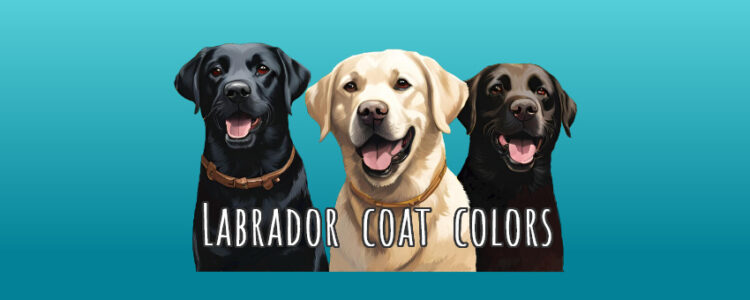
Have you ever wondered about Labrador coat colors? Such as how two black Labs can have chocolate and/or yellow puppies? Or why breeding a chocolate to a yellow often produces all black puppies?
Well, it’s genetics that determines Labrador coat colors. But before we get into all of that, did you know Labs come in four colors? Yep, and I’m not talking about the “designer” dogs in silver or charcoal. You’ve probably even seen all four colors and didn’t realize it.
So what are they?
The three Labrador coat colors (plus one)
Well, there’s black. No surprise there. There’s also chocolate. Again, no surprise.
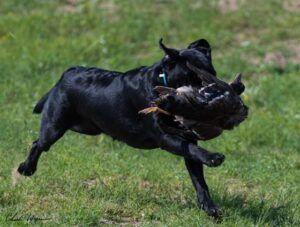

Then we get to the yellows. This color comes in shades from pale cream to rich fox red. They have a black nose and eye rims.
The fourth color looks like a yellow at first glance, but they have a chocolate nose and eye rims. These are called Dudleys and they carry the genes for both chocolate and yellow.



There’s nothing wrong with Dudleys, but they are disqualified in dog shows. Some people think these are light-colored chocolate Labs or a mixed breed. They are neither.
Genetic basics
To understand how the Labrador coat colors are inherited we have to take a look at some science. If there’s a term you don’t understand click to scroll down to Genetic terms.
The blueprint of each dog is contained in its DNA which is made up of 39 pairs of chromosomes. Half of those chromosomes came from the dog’s father and the other half came from the dog’s mother.
Along those chromosomes are genes. Each pair of genes controls a portion of that blueprint. The gene pairs can be the same which is written with two capital letters such as “BB” or two small letters such as “bb” (homozygous). Or they can be different (heterozygous) which is written with a capital and a small letter such as “Bb”.
If they are different, the dominant gene will show and the recessive gene will be hidden.
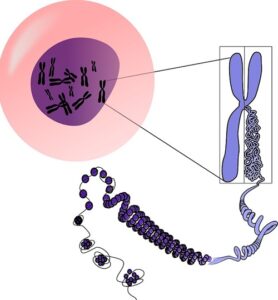
This is a cell with chromosomes and genes.
Applying genetics to Labrador coat colors
In Labs, the gene for black (“B”) is dominant to chocolate (“b”). The “B” or “b” shows that these are two versions of the same gene and that the one with the capital letter is dominant to the small letter.
If the dog has at least one of the “B” genes, he will be black. With an exception we’ll get to. So BB and Bb mean the dog is black, but bb means the dog is chocolate.
Yellow is determined by different genes which can be EE or Ee or ee. The “E” gene determines whether the dog will be yellow or not yellow. If the dog has one copy of the “E” version of the gene, he will be black or chocolate depending on the “B” gene. But if the dog has two copies of the “e” version he will be yellow. That is the exception. Usually a Lab with “BB” genes is black, but if he also has “ee” genes he will be yellow. In this case the yellow gene will override the black gene.
Labs with two copies each of the “b” and “e” genes (“eebb”) will be yellow with a chocolate nose and eye rims. These are the Dudleys. Other people say they’re “NBP” which is short for No Black Pigment.
Labrador coat colors
Okay, so that was a somewhat simplified version of genetics, now we can get into colors.
Dogs need at least one copy of the “B” gene to have a black nose and eye rims. If they also have at least one copy of the “E” gene, they will have a black coat.
A dog with two copies of the “b” gene will have chocolate pigment on the nose and eye rims. If he also has two copies of the “e” gene, his coat will be yellow. However if he has one or two copies of the “E” gene his coat will be chocolate.
Clear as mud? Here’s a chart:
| Lab Colors | Color Code | Description |
|---|---|---|
 |
EEBB | Black, no hidden color |
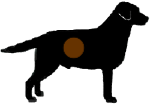 |
EEBb | Black with hidden chocolate |
 |
EeBB | Black with hidden yellow |
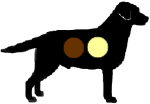 |
EeBb | Black with hidden yellow and chocolate |
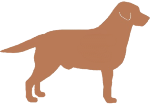 |
EEbb | Chocolate with no hidden color |
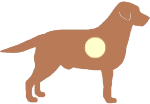 |
Eebb | Chocolate with hidden yellow |
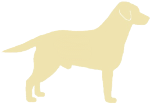 |
eeBB | Yellow with no hidden color |
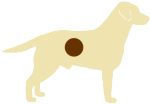 |
eeBb | Yellow with hidden chocolate |
 |
eebb | Yellow with chocolate pigment, including the nose and eye rims – a Dudley |
So those four colors we see break down into nine different colors when we look at the genetics.
Punnet Squares
A Punnet square makes it easier to calculate what colors and approximate percentages we might get in a litter. The father’s contribution is listed along the top and the mother’s contribution is along the side.
Let’s try combining the genes. For the sake of clarity we’ll start with just the black/chocolate gene. If both parents are black, but they carry the gene for chocolate their code is “Bb”.
So we put a “B” and a “b” across the top and a “B” and a “b” along the side.
Here’s how the square looks filled in:
| B | b | |
|---|---|---|
| B | BB | Bb |
| b | Bb | bb |
In this case the genes have a 25% chance of combining as “BB”, a 50% chance of combining as “Bb” and a 25% chance of combining as “bb”. Only the “bb” would show as chocolate.
If the litter size was large enough—more than 100—you would probably see a distribution of colors fairly close to these percentages. However because litter size is much smaller you could get all blacks or all chocolates or somewhere in between.
Here is yellow vs not yellow:
| E | e | |
|---|---|---|
| E | EE | Ee |
| e | Ee | ee |
The EE is basic black. Ee is black that has hidden yellow. And ee is yellow.
Combining the traits
If both parents are black and carry the genes for chocolate and yellow they would be “EeBb” (Ee = hidden yellow, Bb = hidden chocolate). That means they could have black, chocolate, yellow, and/or Dudley puppies.
Below is the Punnet Square combining both “B” and “E” genes. Can you figure out which combinations will be black? Or yellow? Or chocolate? No cheating!
| EB | Eb | eB | eb | |
|---|---|---|---|---|
| EB | EEBB | EEBb | EeBB | EeBb |
| Eb | EEBb | EEbb | EeBb | Eebb |
| eB | EeBB | EeBb | eeBB | eeBb |
| eb | EeBb | Eebb | eeBb | eebb |
Yeowie!! That looks a lot, but there’s really only nine different combinations. The percentages break down like this:
- 25% EeBb
- 12.5% EEBb
- 12.5% EeBB
- 12.5% Eebb
- 12.5% eeBb
- 6.25% EEBB
- 6.25% EEbb
- 6.25% eeBB
- 6.25% eebb
How about the chocolate bred to a yellow that produced all blacks? Was that a mistake?
| Eb | Eb | |
|---|---|---|
| eB | EeBb | EeBb |
| eB | EeBb | EeBb |
Well, let’s see. If dad is “EEbb” (chocolate) and mom is “eeBB” (yellow), all of their offspring will be “EeBb”. The dominant form of “E” is not yellow and the dominant form of “B” is black. So, all of the puppies will be black, but will carry the genes for both chocolate and yellow.
Determining parents’ color
You can also work backwards from the puppies to the parents. For example, if a black male has even one chocolate puppy in his lifetime, he is “Bb”. If he’s been bred to a few yellows and never produced a yellow puppy, he’s probably “EE”. However we wouldn’t know for sure without testing.
If a yellow female has been bred to a black male and they had black and yellow puppies, but no chocolates, what would you conclude? Well, we know dad carries yellow, because he had yellow puppies. But dad’s yellow is hidden so he’s “Ee” and mom is yellow so she’s “ee”.
Because dad is black he must have at least one “B”, but we don’t know anything about the other in the pair. He might carry chocolate while the mother doesn’t have it or she might carry chocolate and he doesn’t. Or it could be that neither carry chocolate. Or they could both carry chocolate and Mother Nature just didn’t pair the genes for the chocolate to appear. So dad would be “EeB?” and mom is “eeB?” (where the ? means an unknown gene). However if mom has a chocolate nose she would be “eebb”.
The “Silver” Labs
Several decades ago a man decided to breed Labs to Weimaraners to get silver-colored “Labradors.” Obviously these are not purebred Labradors despite what some owners think.
Purebred Labradors are “DD”. Weimaraners are “dd” which dilutes their coat color. When these two breeds are bred together you get puppies that are “Dd”. This cross-breed looks similar to Labs, including the coat color, however they carry the dilution gene (“d”). When they’re bred together they can produce the so-called “silver Lab” depending on the color of the original Labrador. Other variations are called charcoal (diluted black) and champagne (diluted yellow).
Unfortunately AKC has allowed these cross-bred dogs to be registered as purebred Labrador Retrievers. It is a mess that needs cleaning up.
Coat Mismarks
When the St. John’s Dog (our Labs’ ancestor) arrived in Britain, there were too few of them to keep the line pure. Some were bred to Pointers or Flat-coated retrievers, others to Collies or Rottweilers.
The St. John’s Dog had strong genes and often produced puppies that looked like a SJD despite the other parent. However some characteristics of those other dogs were added to the gene pool. Most have been bred out, but surprises pop up now and again. We call these dogs mismarks.
Most common is a small white spot on the chest. It’s allowed, but not desirable. Gray hairs from scars or aging are not penalized.
However tan markings, such as Dobermans have, and brindling are disqualifying traits. As is any color other than black, yellow with black nose and eye rims, or chocolate.
Here is a brindle. These are tan or brown dogs with slender black stripes. The color is seen most often in Boxers, Great Danes, and Greyhounds.

Some Labs have tan markings like a Doberman or Rottweiler.

Others are splashed with white or sometimes with black. It’s not common, but I have seen a Lab with a white blaze on his face and another that had white toes. Both dogs are purebred Labradors.
Most interesting of all are the chimeras. This is a rare genetic mutation that happens when two embryos fuse together. In this case, it looks like an embryo of a black puppy fused with a embryo of a yellow puppy.
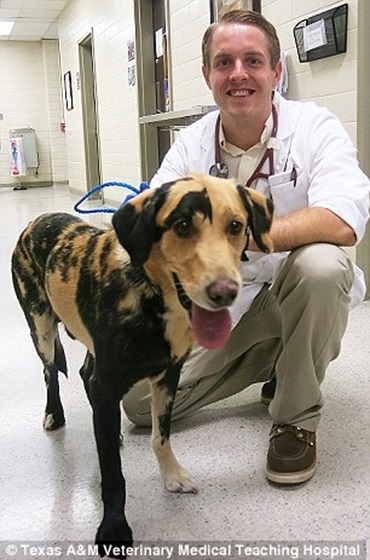
A good Lab is a good Lab, no matter the color
Now you know about Labrador coat colors, both the colors you see and the ones that are hidden. You know Labradors come in black, yellow, or chocolate and sometimes have hidden copies of those colors.
How many unique crosses do you think there are, taking into account the seen and unseen colors? For example, you could breed a black Lab with hidden chocolate to a black Lab with hidden yellow. Or a black Lab with hidden yellow to a yellow Lab with hidden chocolate. Or two black Labs and neither has hidden yellow or chocolate. So these are three to start off, but there are a lot more.
Hint #1: Use the color shorthand. For example, “EEBB” for black with no hidden color. Or “EEBb” for black carrying hidden chocolate.
Hint #2: Be methodical. List all the black variations. Then pair the first variation with each of the variations. Then pair the second variation with each of the variations. And so on.
Frequently asked questions:
Can two black labs have yellow puppies?
Yes, but only if both parents carry the hidden yellow gene.
What color Labradors can you get?
Labrador coat colors are black, yellow, or chocolate. Black is wholly black, although it may have a small white spot on it’s chest. Yellow can range from nearly white to a rich orangish red. Chocolates are supposed to be, well, chocolate.
Is there a coat color test for Labrador Retrievers?
Yes, several laboratories can test for color. I use DDC because they are helpful, with a fast turnaround time, and are less expensive than some other labs.
Does Labrador coat color matter?
For a pet, no, it doesn’t matter. However if you plan to compete in the show ring, it can matter if the dog has any mismarks. Also the so-called “Silver Labs” tend to have color dilution alopecia which is a genetic condition affecting their skin and coat.
Do different color Labradors have different personalities?
Years ago there were rumors that chocolate Labs were hyperactive, yellows were lazy, and blacks were the best of all. Having had many Labs over the years, I’ve never seen temperament connected to coat color.
Which color of Labrador is the best to buy?
It depends on your preference. Some people say chocolate Labs don’t live as long, but my chocolate boy lived to 17. I know someone whose black Lab lived to 18.
Do white Labrador retrievers exist?
Not really. The “polar bear white” Labs that some people advertise are really just a yellow dog with very light pigment.
Should I get a silver Lab?
I would advise against it. They’re not purebred Labradors, but have been mixed with Weimaraner. Plus they’re prone to color dilution alopecia and are often more expensive than purebred Labs.
Genetic terms
Genes
The basic unit of inheritance. Genes are passed from parents to children and contain the information needed to specify physical and biological traits.
Alleles
Different variants of genes. Each parent provides one allele of a pair.
Chromosomes
Thread-like strands that contain hundreds, or even thousands, of genes
Dominant vs Recessive
If one allele in a pair always makes a trait appear, that allele is called “dominant.” The other allele is recessive. For example, a Lab might be black (a dominant trait) and carry an unseen chocolate allele (a recessive trait). The dominant allele is shown as a capital litter and the recessive allele is shown as a lower-case letter, for example Bb.
Genotype
The entire set of genetic material of a dog (or cat, person, etc).
Phenotype
The physical characteristics of something living, especially those characteristics that can be seen
Homozygous
The same alleles of a gene from both the parents (written as two capital letters, such as BB)
Heterozygous
Different alleles of a gene from the two parents (for example, Bb)
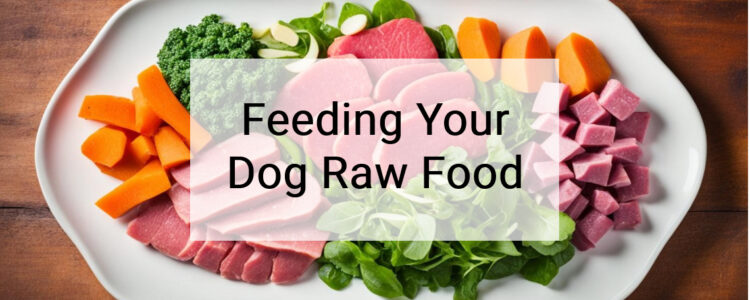
You love your dog, right? And you probably want to feed him the best food.
Looking at his teeth you can see he’s a carnivore with teeth made to rip chunks of meat. That’s very different from horse teeth that are meant to grind their food. So why feed kibble that needs more grinding than ripping?
Read on to learn more about feeding raw food.
What is a raw food diet for dogs?
This diet for dogs includes meat, organs, raw bones, and fresh produce. These foods are not cooked and don’t have any additives or preservatives. The idea is to provide a more biologically appropriate diet than dry dog food.
Why should I feed my dog raw food?
For thousands of years dogs and their ancestors hunted and ate the meat raw. When they first joined our households, they ate scraps.
Now many dogs eat commercial food which is usually kibble or canned. Those foods are often cooked which destroys some nutrients. Pet food manufacturers try to add back what was destroyed, but synthetic isn’t always as good as natural ingredients.
As an example, cats developed health problems and died when fed commercial food. Although taurine is abundant in raw meat, they didn’t know it was essential until recently.
It’s only in the last 80 years or so that people started feeding dogs commercial foods. It’s not a coincidence that dogs started developing cancer, heart disease, and allergies just like people who eat processed foods.
What are the health benefits of raw food for dogs?
Feeding raw food helps with digestion and skin health, making it a top choice for dog owners.
Raw meat is easier for dogs to digest which means better nutrient absorption and less waste. You’ll notice firmer poop and fewer tummy troubles.
A raw diet is full of fatty acids and other nutrients that make skin and fur healthy.
There aren’t harmful additives such as BHA that’s often added to store-bought dog food.
| Benefits of Feeding Raw Food | Potential Drawbacks of Raw Feeding |
|---|---|
| Closer to a dog’s natural diet | Requires a bit more thought and effort than pouring kibble in a bowl |
| Nutrient-dense so he needs less and there’s less you-know-what to pick up in your yard | Handling raw meat comes with safety considerations |
| Feeding a variety of meat sources can lead to fewer allergies | Potential for unbalanced nutritional intake |
| Healthier skin and coat | Preparation time and storage requirements |
Is a raw food diet complete and balanced?
If you give your dog a variety of raw, meaty bones (“RMB”) you will have a balance over time. Except for the raw part, that’s pretty much how we eat.
Because chicken is widely available and fairly inexpensive, many people feed mostly chicken. However you should feed as wide a variety of foods as your dog will eat (and your wallet can handle).
For example:
- chicken backs, necks and quarters,
- rabbit parts,
- turkey necks,
- pork necks,
- beef ribs, heart, liver, tongue,
- eggs (whole, including the shell).
My friends have also given me goat, fish, deer, elk, and buffalo meat.
I have several Labs so I often buy in bulk at a restaurant supply business. Sometimes their stock varies, but I usually buy ground turkey, chicken quarters, and beef heart. That’s about 60-80 pounds of meat.
When I have puppies I’ll usually start them on gruel which is kibble soaked in about 50/50 goat’s milk and water. Then they’ll graduate to ground up chicken wings, and finally to intact wings. When you see them snatch the wings you’ll realize how high they value raw food.
Again, if you feed anything with bones it must not be cooked.
And I also feed fruit and vegetables, but they’re not a big part of my dogs’ diet. For things they like – apples, avocado, carrots, celery (but not bananas, for some reason) – I chop into bite-size pieces. Other things like spinach and cauliflower get chopped up in the grinder and mixed with ground meat.
Won’t raw food make my dog sick?
Dogs and their ancestors ate a raw food diet for thousands of years. It’s only after they started eating commercial dog food that health issues increased.
For example, in 2007, hundreds of pets died of kidney failure after eating kibble contaminated with melamine and cyanuric acid. Melamine is a compound used to make Formica, plastic dinnerware, insulation, cleaning products, and dry erase boards. The contamination was traced to companies in China that make animal feed. These companies reportedly added the chemicals to “give the false appearance of a higher level of protein.”
Shouldn’t I cook the meat?
No, and there are several reasons not to cook it. First, dogs evolved to eat raw meat. Second, cooking causes bones to become brittle and dangerous. Never feed cooked bones to your dog. Third, cooking will destroy enzymes and anti-oxidants essential to your dog’s health.
In the 1930s, Francis Pottenger M.D. did an experiment with cats. He fed one group of cats a raw food diet and a different group a cooked diet.
The cats eating the cooked diet developed problems such as tooth loss, deformities, behavioral problems, paralysis, heart lesions, and arthritis. Mother cats had more miscarriages and some died giving birth.
Fortunately when they were later fed a raw food diet, many were restored to health.
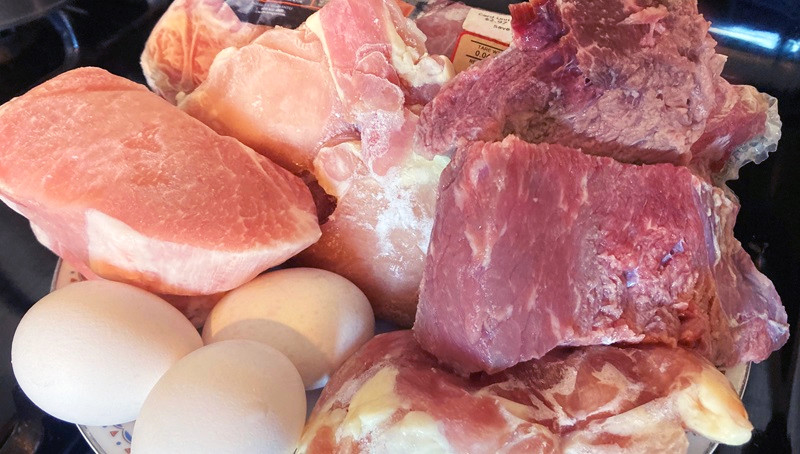
Can’t my dog choke on a bone?
Yes, dogs can (and have) choked on many things including bones, kibble, tennis balls, sticks, and socks. Dogs can also break their teeth on bones. Therefore you should feed raw bones of a manageable size, including poultry, rabbits, and non-weight bearing bones of larger animals.
Make sure the pieces are large enough so that your dog has to tear and chew rather than gulping. Gulping can cause choking. One of my dogs tried to swallow a chicken quarter whole. From then on he got to chew on the thigh while I held the end of the drumstick.
If you’re worried about feeding bones you can still get some benefits of a raw food diet by feeding ground meat. Although that’s fine for an occasional meal, your dog also needs the additional nutrients found in bones. You can add ground up bones or bone meal to balance nutrition. Check with your veterinarian for advice.
Another option is buying a raw diet, ground and specially prepared for dogs. You can find these in pet stores and some grocery stores. However there are two downsides: less knowledge about the ingredients and the cost.
Are there risks feeding raw meat?
Raw meat can carry harmful germs like salmonella or listeria. These could make your dog, you, and your family sick.
Try to buy meat from a butcher or high-quality supplier. Wash your hands and surfaces before and after handling raw meat.
Pork has a reputation that it must be cooked well-done because of a parasite that could be in the meat.
According to WebMD, “Eating raw or under-cooked pork can also result in trichinosis, an infection of parasitic roundworms called Trichinella. While trichinosis symptoms are usually mild, they can become serious — even fatal — especially in older adults.”
However, according to the CDC, “… meat contaminated with the Trichinella larvae comes from meat-eating animals such as bear, wild boar, or walrus.” (Note: I don’t feed meat from meat-eating animals.) They go on to say it “is a rare disease in the United States, with only about 15 confirmed cases per year.”
I do feed pork but I freeze it for 20 days at 5°F (-15°C) to kill any worms.
Can you give me some recipes?
Just give your dog a variety of raw, meaty bones as the main course. Chicken, beef, pork, and turkey are often easiest to find, but also look for rabbit, goat, and other species.
Add some heart or liver, plus a little boneless meat, and maybe some mashed up vegetables.
You can also add some eggs (including the raw shell), some fish (whole, if possible), and perhaps some yogurt (with active cultures).
When you’re starting out, plan a week’s worth of meals. If you feed twice a day choose nine meals of RMBs, two meals of muscle meat, and three veggie meals.
If you look in the ‘fridge and there are only packages of muscle meat when you’re supposed to be feeding an RMB, don’t worry. Give an extra meal of RMBs and relax. Your dog won’t care. Just remember you’re striving for balance over time.
By the way, you can make your own treats in addition to raw goodies. Check out these recipes for healthy dog cookies.

Transitioning to raw food
It’s best to start simply: one type of RMB for the first week or two. Don’t add any supplements or try different RMBs for awhile. It might take your dog a little time to adjust to this new food.
Some dogs do best on a cold turkey switch rather than half-kibble and half-raw, others may need to be eased into a raw food diet.
Keep it bland in the beginning. You might start with chicken or turkey and feed wings, necks or backs for the first few days. Some dogs may take a little while to adjust, and you may see some diarrhea. If so, you can try adding some canned pumpkin (not the pie filling) or increase the percentage of bone.
You might see a little vomiting. Sometimes it’s bits of bone that he couldn’t digest, other times it’s a yellow foam that means his stomach is empty. Raw meat usually digests faster than kibble, so you may need to feed more often.
Starting out, you might add some yogurt with active cultures or some digestive enzymes to help his digestive system. I use Dynamite’s DynaPro. It’s a pre- and probiotic and only takes a few drops to a small squirt. (Note: If you buy it after clicking on this link, I’ll earn a small commission.)
As your dog adjusts, add another type of RMB (not just a different body part, but a different species). Feed just those two meats for several days or more until your dog seems comfortable with his new diet.
Then gradually try different foods. See what your dog likes. Some love fish, some hate it. Some love veggies, some won’t touch it.
Wait to add richer foods like liver or heart until your dog is handling the basic raw diet.
How much should I feed my dog?
As a starting point dogs should eat about two to three percent of their ideal adult weight.
First you need to find out how much he weighs. Drop in at your vet’s office if he’s too big for your home scale. Then multiply by two percent and again by three percent. For a 70 pound Labrador, that would be about 1.5-2 pounds of food.
Depending his activity level and body score, you may need to adjust the amount you feed.
Puppies should also receive about 2 to 3 percent – not of their current weight – but of their ideal adult weight.
And don’t worry about giving your dog the same exact amount every day. Just keep the amount close to the two to three percent of his weight. Bump it up a bit if he starts looking thin or cut back a little if he’s getting pudgy.
Tips for switching to raw food
Switch slowly so your dog’s stomach can get used to the new food.
How much food your dog needs depends on their size and health needs.
Be sure to talk to your vet about any problems your dog might have with raw food.
To supplement or not?
Feed a variety of raw meaty bones, some muscle meat, and a bit of organ meat and you probably won’t need to supplement.
However commercially-raised animals might not be as nutritious as wild animal meat. To balance it out you can supplement with salmon or fish-body oils that contain high amounts of Omega-3.
By being careful you can give your dog the benefits of raw food. And I bet he’d love the change!
Now that you know what food to feed your dog, maybe you’d like to know what NOT to feed him.
NOTE: The information on this website is not intended to replace your veterinarian’s advice. This information is intended to provide non-technical information in an easy-to-understand format. The website author accepts no responsibility or liability for how this information may be interpreted or construed, or any actions that might be taken as a result of the information herein.

I was dusting my shelves and noticed I have a LOT of books about dogs in general and Labradors in particular. My library isn’t limited to Labs, but also includes books on other breeds, plus books on training, care, and breeding. Here’s a list to help you decide what books you need in your library.
Labrador history
The Labrador Dog – Its Home and History (1936)
– Lord George Scott and Sir John Middleton
This is one of my favorite books! It was written by Lord George Scott, brother of the 7th Duke of Buccleuch, and Sir John Middleton, the former Governor of Newfoundland. Lots of early history! Although the book’s cover isn’t in great shape, the interior is well preserved. Even the fold-out pedigrees on tissue paper are intact.

The Popular Labrador Retriever
– Lorna, Countess Howe
It’s a typical dog book, but having been written by one of the greatest proponents of the breed makes it special. She knew many of the early breeders and their dogs, often buying the best dogs she found. She wrote of the founding of the breed, the early dogs and their breeders. A story she included was about Lord Knutsford (then the Hon. Arthur Holland-Hibbert). He wanted to import a dog to add to his Munden strain and asked a friend for help. His friend didn’t find a dog, but was told “You will get a better one nearer home from a young fellow called Holland-Hibbert who lives at Munden, Hertfordshire.”
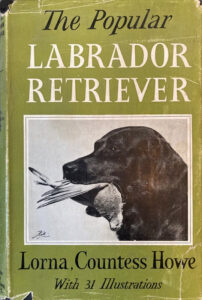
The Labrador Retriever – The History, The People
– Richard A Wolters
A comprehensive book about the Labrador Retriever. It starts with a detailed dive into the beginning of the breed based on the author’s review of early sources. He explains what sources he used and how they fit together, but it’s still like a jigsaw puzzle with some pieces missing. He continues onward discussing the Lab’s journey to England and Scotland, plus the times the breed nearly ended. Then the export to the US and breeders such as Jay Carlisle of Wingan put Labs on the path to popularity.

Other Labrador Retriever topics
The Dual-Purpose Labrador
– Mary Roslin-Williams
This book was published in 1969 by a woman who knew Labradors. Any book by MRW is worth reading and this one doesn’t disappoint. If you can find a copy available, snap it up. Then be sure to read the chapters on Type and Conformation. You may also want to listen to one of her lectures as well.

Reaching for the Stars
– Mary Roslin-Williams
Previously titled Advanced Labrador Breeding, this book is all about breeding. She discusses successful breeders and the qualities that make a good breeder. The part I found most interesting was her description of the stages a breeder goes through.

Legends in Labradors
– Nancy Martin
The author visited many important breeders, both in the UK and the US, and wrote a series of profiles. Included are Sandringham, Banchory, Ballyduff, Blaircourt, Cornlands, Hiwood, Knaith, Mansergh, Sandylands, and more from the UK. Plus Arden, Chidley, Deercreek, Earlsmoor, Franklin, Lockerbie, Nilo, Whygin, Wingan, and others from the US. The profiles aren’t long or in depth, but they give you a taste of why these kennels were so important.
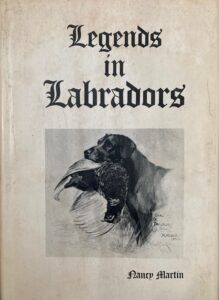
The Book of the Labrador Retriever
– Anna K. Nicholas
Starts by discussing the origins and standards of the breed, and provides advice on caring for, showing, and obedience training Labradors. But what sets it apart from many breed books is the information on kennels in the US and Canada. Kennels included Beechcroft, Broad Reach, Campbellcroft, Chidley, Finchfield, Franklin, Killingworth, Kimvalley, Lockerbie, Mandigo, Rupert, Scrimshaw, Shamrock Acres, Simerdown, and Whygin.

The Official Book of the Labrador Retriever
– Labrador Retriever Club Inc
Another comprehensive book about Labradors, although not so deep as Richard Wolters’ book, The Labrador Retriever. It has a section on history of the breed, but more interesting are the pedigrees and photos of Labs. Many of the highlighted bloodlines are from Europe and especially England and Scotland.
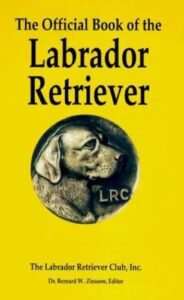
The Complete Labrador Retriever
– Helen Warwick
A lovely book that lives up to its name. If you want to learn about Labrador Retrievers – albeit at a high level rather than a deep dive – this is the book for you. Mrs. Warwick does a good job condensing the Lab’s history and yet keeping it readable. Other chapters discuss yellows and chocolates, Labs in other countries, showing, and breeding.

The Ultimate Labrador Retriever
– Heather Wiles-Fone
This is a large book with each chapter penned by an authority on that topic. Learn about Lab history, raising a puppy, training, showing, breeding, health, and more. And each chapter is complete enough to be its own book.
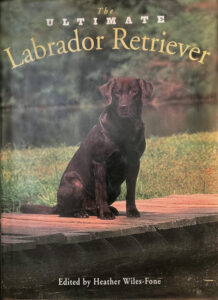
Sandylands
– Richard Edwards
A very in depth book about the Sandyland dogs – mostly Labradors, but also some other breeds. Follow along as Labs twine through Gwen Broadley’s life, from Juno through Tandy, Tweed, Mark, and many others. If you have any questions, the author is active on Facebook. And he also wrote a chapter in The Ultimate Labrador Retriever as did Marjorie Satterthwaite.

The Retriever Owner’s Encyclopedia
– Gwen Broadley
I stumbled upon this book recently and bought it because the author bred so many wonderful dogs under the Sandylands name. The book is more of a dictionary of dog terms, some simple and other lesser known terms such as haw, eclampsia, and timber. What I liked best was the sprinkling of photos including Sandylands Tweed of Blaircourt, Sandylands Tandy, Lockerbie Kismet, Knaith Banjo, and Reanacre Mallurd Thunder retrieving a fox. Although most of the photos are of Labs, there are also some of Goldens, Flatcoats, and Curly Coated dogs too.

The Labrador Retriever
– David D Elliot
Numbered edition, mine is #18
A little book with basic Labrador care instructions, but what sets it apart are the number of photos of dogs from the Wingan kennel. Mr. Carlisle did an awesome job importing and breeding the best Labs. He was also very giving with his time to help other breeders. When he died he left his dogs to his trainer, David Elliot.
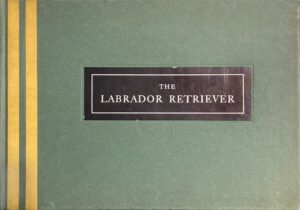
Life Magazine, Issue December 12, 1936
This issue included an article about Blind of Arden with an arresting photo of him on the cover. The article talked about his win at the “No. 1 U.S. Retriever Test” and included several photos. At that time, Labs were still new to the US.

A Dog Owner’s Guide to Labrador Retrievers
– Marjorie Satterthwaite
This is a nice little introduction to Labs book, but I bought it for sentimental reasons. I met and talked with Mrs. Satterthwaite at the 2004 LRC National Specialty. She said some nice things as she went over my dog, even though we both knew Arwen wasn’t a show dog. We talked again at the hunt test when I gave her a photo of her judging my friend’s dog the day before. She passed away just a few years later.
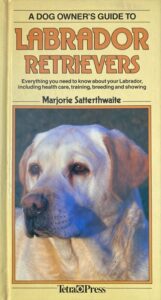
Health
The Nature of Animal Healing
– Dr. Martin Goldstein
I got to meet Dr. Marty when he was on his book tour. He’s such an inspiration! In his book he gives several ways to help your dog live longer and healthier. If you want to jump right into raw feeding, he tells you how to do it. Not quite ready to go all the way? He has tips to ease into it. I eased in because it’s hard to give your dog raw meat – bone and all – and wonder if it’s safe. But they loved it and I got over being fearful (mostly). I also think it helped my chocolate Lab live to 17 years old.

Keep Your Dog Healthy the Natural Way
– Pat Lazarus
This book is similar in many ways to The Nature of Animal Healing. It talks about feeding a natural diet and gives variations for females in whelp and another for puppies. Plus it explains why a natural diet is better. It also covers alternatives to vaccinations and the benefits of alternative medicine such as chiropractic, acupuncture and homeopathy.
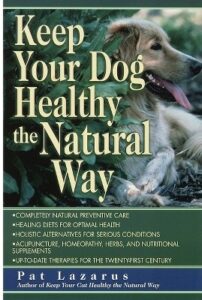
Field training and history
History of Retriever Field Trials in America
– Fred Kampo and Carolyn McCreesh
A signed, limited edition book that looks great on the coffee table. More than that it provides a detailed glimpse into the start of field trialing in the US. It includes information about the dogs’ performances, the handlers and owners, and the estates where trials were held. I love the amount of photos included and the depth of detail. However I wish that sub-headings had been used to make it easier to find specific information.
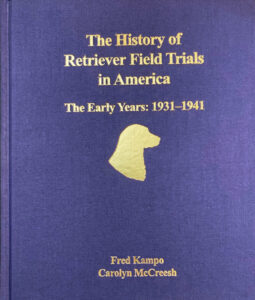
Mike Lardy’s training articles
– Collections 1 & 2
Collections of articles written by one of the most successful field trial trainers. Covers basic training through blinds, although it’s not very detailed. I recommend getting the first collection to get a good overview on field training. He also offers various videos that are more expensive, but can be a great help if you learn better visually. Most trainers I know use Lardy’s training progression or something very similar. Available through Total Retriever Training along with several great videos/DVDs.
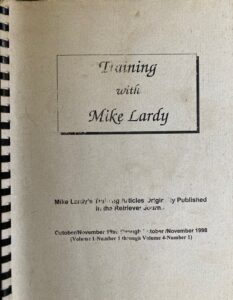
Tri-Tronics Retriever Training
– Jim & Phyllis Dobbs
Step-by-step program for retriever training which emphasizes “making it easy for dogs to learn.” Excellent section on the use of the electronic collar. There are also some concepts gathered from Schutzhund training. By the way, if you use Lardy’s program, skip this book or vice-versa. Trying to use both will confuse your dog.
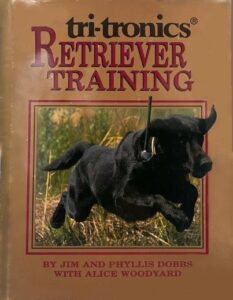
Training Retrievers for the Marshes and Meadows
– James B Spencer
A rather chatty book that starts with choosing a puppy and works its way through beginning to advanced blinds and marks. It does work, but you might want to pick up his other books that go into more detail on marking and running blinds.
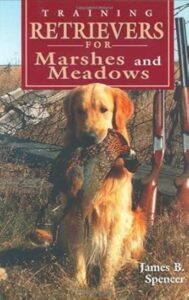
Training Retrievers to Handle
– DL & Ann Walters
Very in depth book, but worth reading to understand the steps involved in teaching a dog to handle.
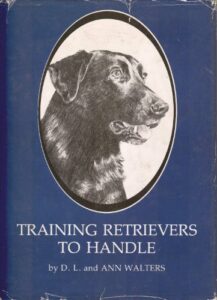
Retriever Training Drills for Marking
– James B Spencer
Because we can’t have a chat with our dogs and explain what we want – in a way they understand – we need drills. Some drills help teach a skill, others are used to refine a behavior. Drills are introduced during basics training and repeated over several training sessions. This book includes a variety of drills to help dogs pinpoint the area of the fall and go straight there.

Retriever Training Drills for Blind Retrieves
– James B Spencer
Most drills have been developed by pros who need ways to teach dogs a concept. Some drills have been shared, while other drills have stayed within a group of people. For example, wagon wheel and 3-hand casting drills are well known. This book does a deep dive into a variety of drills including the purpose of the drill, equipment needed, precautions to take, and a step-by-step description.
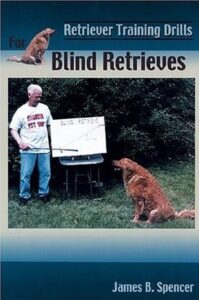
Retriever Training Tests
– James B Spencer
I wish more judges would read this book. Some judges have never hunted which leaves them at a disadvantage. They compensate by setting up a test similar to what they’ve seen as a competitor. Unfortunately they often don’t understand the ‘why’ of that set up. Other judges have lots of hunting experience which really helps them set up a realistic test. Sometimes, however, what happens in an actual hunt doesn’t transfer well to a testing environment.
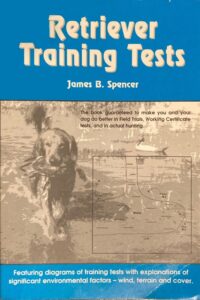
Water Dog
– Richard Wolters
A classic! Many dogs have been trained using this book, however there are newer books available. I think some of the new techniques are easier for the dogs to learn.
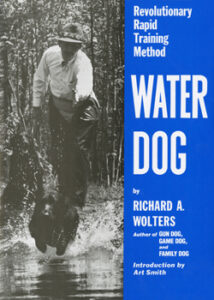
Game Dog
– Richard Wolters
Another good book and similar to Water Dog, but it focuses more on training for upland hunting. I like that it has a step-by-step method.

Other dog training books
Expert Obedience Training for Dogs
– Winifred G. Strickland
I have a couple of Bill Koehler’s books and his methods work. However I like more of a partnership rather than a master and servant relationship. Mrs. Strickland worked with her dogs and developed top obedience competitors that were happy and enthusiastic in their work. It also includes how to train tricks and basic tracking.
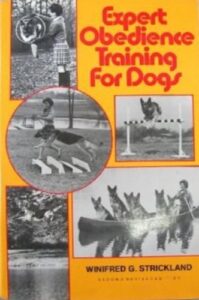
Peak Performance
– M. Christine Zink DVM
How to keep dogs fit and active by a consultant on canine sports medicine. Owners should learn their dogs’ health needs and how to keep them fit to compete successfully.
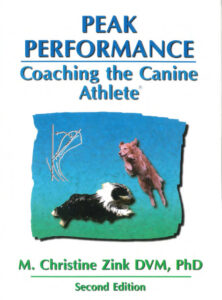
Beyond Basic Dog Training
– Diane L Bauman
A more recent book on obedience training that allows dogs to learn by trial and error. The dog isn’t corrected and so isn’t afraid of failing. I’ve heard many obedience trial champions have been trained using this method.

Tracking Dog Theory & Methods
– Glen R. Johnson
An oldie, but if you follow his methods your dog should be ready to run a TD test in about two months. It’s the best all-around book for understanding how to train a dog to track. It includes a schedule to train for TD and TDX titles, although it doesn’t include any information about the VST title.
Component Training For Variable Surface Tracking
– Ed Presnall and Christy Bergeon
Breaks down training for VST into specific skills. Not particularly easy to read, but it is the best book available on VST training.
Other books you need
The New Art of Breeding Better Dogs
– Kyle Onstott
This book does a good job of explaining how to combine genes to create a better dog. It includes an excellent chapter on inbreeding, line breeding, and outcrossing.

The New Knowledge of Dog Behavior
– Clarence Pfaffenberger
Research on how and when puppies are socialized makes a big difference in how well they can adapt to life with people. This led to discovering the critical stages of puppy development. If that time is missed the puppies may never be able to bond with people.
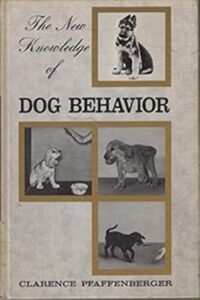
I also have a lot of yearbooks and compilations:
The Labrador Retriever Club (UK) Stud Book and Record of Field Trials 1949 – with an introduction by Lorna, Countess Howe
The Labrador Retriever Club 1931-1956
The Handbook of Amateur Retriever Trials, 1951-1961
Labrador Retriever Bench Records, 1967-1983
Retriever Field Trial Performances (I have almost all volumes, although I’m still looking for the 1979-1984 edition and volumes from 2009 forward.)
Some of the books are rather old and out of date, but there’s still good information in them. Just don’t get me started on magazine collections!
What are YOUR favorite dog books?

Exercise Induced Collapse (EIC) causes weakness and collapse in some dogs, particularly in very active and excitable dogs. It is caused by a gene mutation affecting some breeds.
If you have a Labrador, Chessie, or any other breed prone to this condition, you’ll want to pay close attention. Let’s dive into what EIC is, how to spot it, and most importantly, how to keep our dogs safe and healthy.
What is Exercise Induced Collapse?
Exercise Induced Collapse is a genetic condition that affects certain dog breeds, causing them to collapse after intense physical activity.
Imagine playing fetch with your energetic Lab, only to see him suddenly stumble and fall after a few minutes of running. It’s a scary sight, but understanding EIC can help us prevent these episodes and help our dogs lead happy, active lives.
Which breeds are most affected?
While EIC is most commonly associated with Labrador Retrievers, it’s not exclusive to them. According to UC Davis Veterinary Genetics Laboratory, the breeds that may carry the EIC gene are:
- Australian Cobberdog
- Australian Labradoodle
- Bouvier des Flandres
- Boykin Spaniel
- Cardigan Welsh Corgi
- Chesapeake Bay Retriever
- Cockapoo
- Cocker Spaniel
- Clumber Spaniel
- Curly Coated Retriever
- Deutsch-Drahthaar
- English Cocker Spaniel
- German Wirehaired Pointer
- Labradoodle and other crosses
- Labrador Retriever
- Old English Sheepdog
- Pembroke Welsh Corgi
- Vizsla
EIC can affect both male and female dogs. It can also occur in mixed breeds, such as doodles and dilutes, that have genetics from one of the affected breeds. And it’s in both field and show lines.
What does an EIC episode look like?
Picture this: You’re at the dog park on a warm summer day. Your Labrador is having the time of his life chasing after his favorite ball. Suddenly, you notice his gait becoming unsteady. His back legs seem weak, and he’s struggling to keep up with the other dogs. This could be the beginning of an EIC episode.
Key symptoms to watch for include:
* A rocking or wobbly gait
* Weakness in the hind legs
* Dragging of the back legs while still running with the front legs
* Collapse after 5-15 minutes of intense exercise
It’s important to note that these episodes are often triggered by a combination of factors, not just exercise alone. High excitement, stress, and warmer temperatures can all contribute to an EIC episode.
The science behind Exercise Induced Collapse
EIC is caused by a specific gene mutation. For a dog to be affected, both parents must carry at least one copy of the gene. Interestingly, about 30% of tested Labradors carry this gene. That’s why genetic testing is important for breeding programs and for pet owners who want to be proactive about their dog’s health.
I use DDC for testing because they’re fast, helpful, and they don’t charge for tests that aren’t a problem for Labradors. They also show the results in plain English. For example:
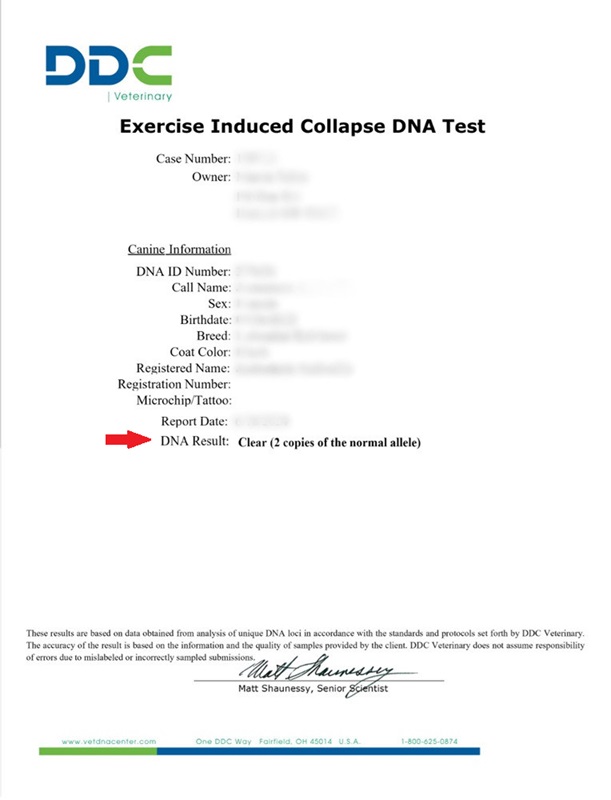
If you use a different laboratory, they may report the results as N/N, or N/EIC, or EIC/EIC.
For results that are N/N, the dog won’t collapse due to EIC and won’t transmit an EIC gene to puppies.
If the test results are N/EIC, the dog won’t collapse, but can pass the gene on to puppies.
Or if the test results are EIC/EIC, the dog may collapse at some point.
Preventing EIC episodes
To keep your EIC-prone dog safe:
- Avoid strenuous exercise in warm weather
- Stop all activity at the first sign of weakness
- Stick to mild or moderate exercise for affected dogs
- Consider removing high-energy, excitable dogs from intense training programs
Our dogs still need exercise and mental stimulation, but we need to be mindful of their limits.
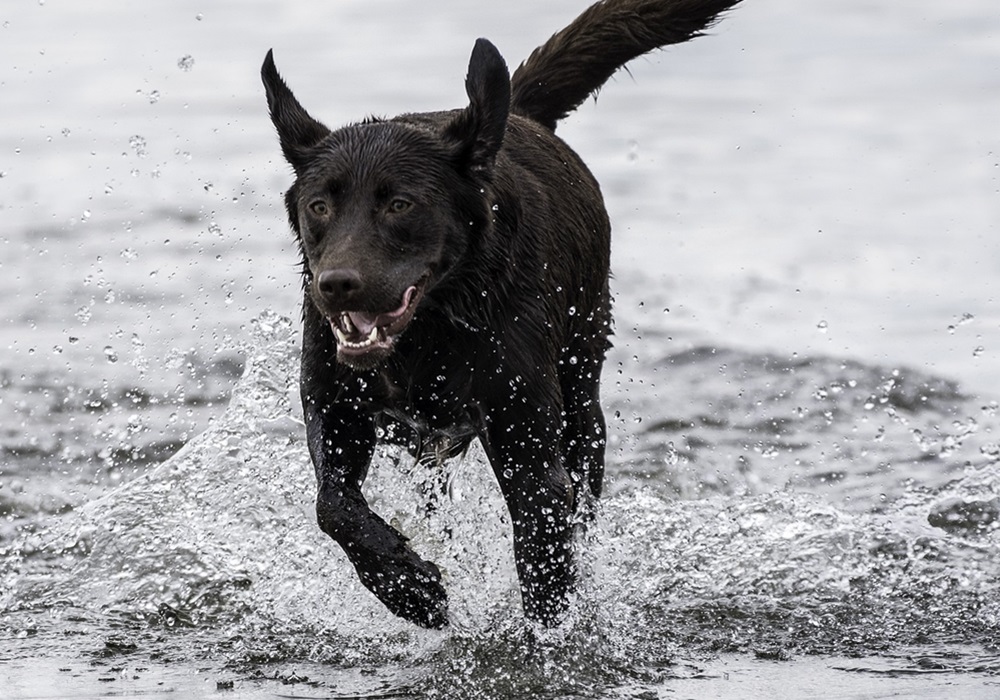
Image by Yinan Chen from Pixabay
What to do during an EIC episode
If you suspect your dog is having an EIC episode, stay calm and follow these steps:
- Immediately stop all exercise
- Move your dog to a cool, shaded area
- Offer small amounts of water
- Lightly spray your dog with cool (not cold) water if they seem overheated
- Allow your dog to rest and recover gradually
Most dogs are alert, but may seem confused. Some dogs may still try to run and their front legs might be stiff. Or they may not be able to move their head and legs. They don’t seem to be in pain. Body temperature is often high.
Symptoms may worsen for a few minutes, but after 10-20 minutes the dog should start returning to normal. It may take longer for their body temperature to return to normal.
The good news is that most dogs recover from EIC episodes within 5-25 minutes, with no lasting effects. However, it’s always best to consult with your vet after an episode to ensure there are no underlying issues.
Living with an EIC-prone dog
Having a dog with EIC doesn’t mean they can’t enjoy an active lifestyle. My friend Debbie has a Labrador named Tucker that was diagnosed with EIC. At first, she was worried that Tucker’s days of fetch and swimming were over. But with some adjustments, Tucker still leads a fun, active life.
Debbie found that shorter play sessions, indoor games during hot weather, and swimming were great ways to keep Tucker happy and healthy. She also learned to read Tucker’s body language, knowing when to call it quits before an episode could occur.
There are other problems with similar symptoms:
Overheating (this can be an emergency)
- frantic panting, increased heart rate, extreme drooling, labored breathing, bright red membranes
- may be dizzy and appear confused
- may collapse and/or experience seizures
- may vomit and/or have diarrhea
Centronuclear Myopathy (CNM)
- gait abnormalities
- generalized weakness
- tires easily
- muscle wasting
- symptoms usually develop as a puppy (2-5 months old)
- once the symptoms develop they are almost constant
If you’d like more information about CNM, go to What is CNM in Labradors?
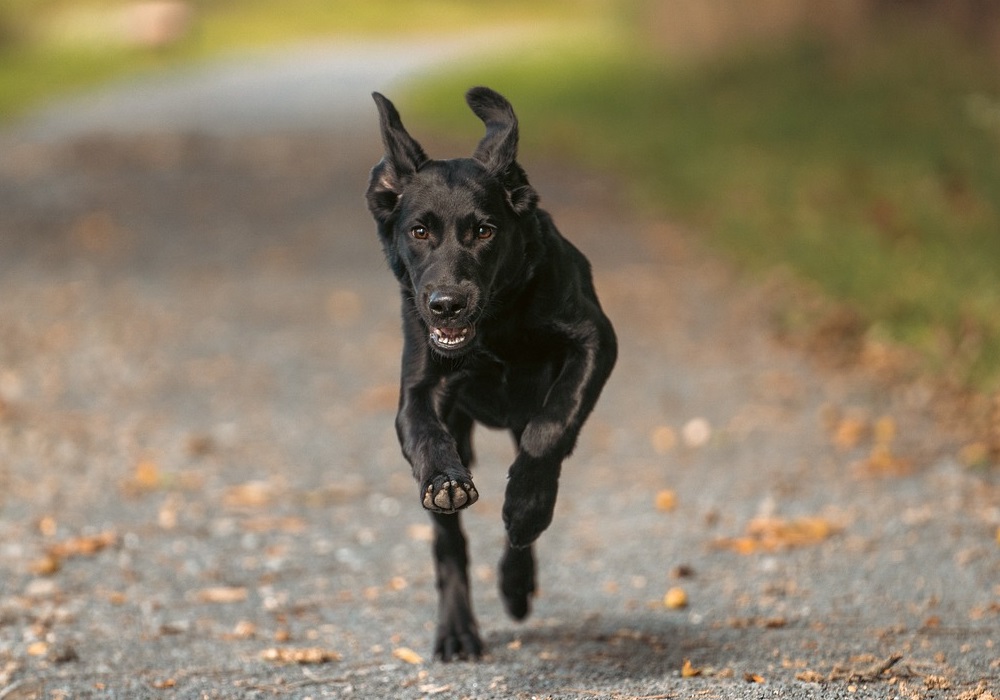
Image by Joshua Choate from Pixabay
FAQs About Exercise Induced Collapse
Q: Can EIC be cured?
A: There’s no cure for EIC, but it can be effectively managed through lifestyle adjustments and careful monitoring.
Q: How is EIC diagnosed?
A: EIC is typically diagnosed through genetic testing and observation of symptoms during exercise.
Q: Will my dog with EIC have a shorter lifespan?
A: EIC itself doesn’t typically affect a dog’s lifespan if properly managed.
Q: Can dogs with EIC still participate in dog sports?
A: While high-intensity sports might be off the table, many dogs with EIC can still enjoy low-impact activities and modified training programs.
Exercise Induced Collapse is a manageable condition that doesn’t have to drastically alter your dog’s quality of life. With awareness, prevention, and proper care, our EIC-prone pups can still lead happy, active lives.
Knowing how to prevent and possibly deal with an episode can keep your dog healthy and safe. So, the next time you’re at the dog park or out for a hike with your dog, keep these insights in mind. Your dog will thank you for it!
NOTE: The information on this website is not intended to replace your veterinarian’s advice. This information is intended to provide non-technical information in an easy-to-understand format. The website author accepts no responsibility or liability for how this information may be interpreted or construed, or any actions that might be taken as a result of the information herein.
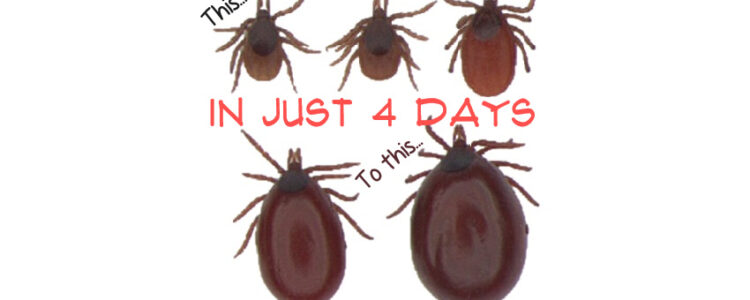
Ticks are tiny, blood-sucking parasites that can cause serious health problems in dogs. They live in tall grass, brushy and wooded areas where they can latch onto pets and feed on their blood.
Tick-borne diseases are a growing concern for dog owners as these illnesses can be hard to diagnose and treat.
About ticks
Ticks are related to spiders and mites. They feed on the blood of mammals, birds, and reptiles and can spread diseases to people and animals.
There are several species of ticks that can vary in size from 1mm (about the size of a pencil tip) to 6mm. When feeding, sometimes for days, they will get larger as they gorge on blood. They can be green, brown, black, or white, depending on the type and age of the tick.
Some of the most common ticks that can affect dogs in the United States include the American dog tick, lone star tick, brown dog tick. and black-legged tick.
If you find a tick crawling on you or your dog, scoop it into a small jar filled with rubbing alcohol. Don’t squish a tick because that could spread any disease it might be carrying. Not every tick is infected, but it’s better to treat them like they are.

“This is a tick that was fully engorged on a dog and fell off. It was put in a ziplock bag and we waited to see what happened to show you all. It’s been in the bag for 2 weeks with no air flow and started to lay eggs about 5 days ago, continuing to do so even still today. Imagine not knowing this was on your animal and it fell off in your house. You’d have 1000’s of baby ticks. GROSS! Please make sure your animals are currently being treated with flea and tick prevention. We know how prevalent they are in our area.”
Tick-Borne Diseases
Ticks spread disease by first feeding on an affected animal (or person) and later feeding on another animal (or person). When feeding, they insert their mouthparts into the host and drink the blood. Meanwhile, the tick’s saliva enters the host, potentially spreading disease.
They can transmit several diseases to dogs, some of which can be life-threatening. The most common are:
Lyme disease:
Bacteria carried by black-legged ticks cause this disease. Symptoms include fever, joint pain, headache, fatigue, and loss of appetite. In some cases, Lyme disease can cause kidney damage, heart problems, and neurological issues. Lime disease is in the upper midwestern, northeastern, and mid-Atlantic states and also on the west coast. There is a vaccine for Lyme.
Signs and symptoms: The first symptom is often a circular rash at the bite site that slowly grows to about two inches in diameter. It’s rarely itchy or painful. Other symptoms include fever, chills, and fatigue. Over time there may be additional rash sites and nerve damage that causes weakness and numbness.
Ehrlichiosis and Anaplasmosis:
Bacteria, carried by an infected tick, cause these infections. Lone star ticks carry ehrlichiosis, black-legged ticks carry anaplasmosis. Symptoms are similar and include fever, headache, chills, fatigue, loss of appetite, and joint pain. In severe cases, ehrlichiosis can cause anemia and bleeding disorders, and anaplasmosis can cause respiratory distress and neurological issues. Ehrlichiosis is in the southeastern and south-central states. Anaplasmosis is in the upper Midwest and northeastern states.
Signs and symptoms: fever, chills, fatigue, muscle pain, nausea, vomiting, diarrhea
Rocky Mountain Spotted Fever:
RMSF is a bacterial disease spread by an infected tick. Early symptoms include fever, headache, fatigue, stomach pain, and loss of appetite. RMSF is most common in North Carolina, Tennessee, Missouri, Arkansas, Oklahoma, and along the US-Mexico border, but it does occur in every state.
Signs and symptoms: rash, fever, fatigue, swelling around the eyes and hands, nausea, vomiting, diarrhea. Later there may be necrosis, trouble breathing, brain swelling, and coma.
If you think your dog may have a tick-borne disease, check with your veterinarian immediately.
Tick life stages
Each row shows an adult female, adult male, nymph, and larva of a species.
Top row: American dog tick
Middle row: Black legged tick
Bottom row: Lone star tick
Image courtesy Cornell University
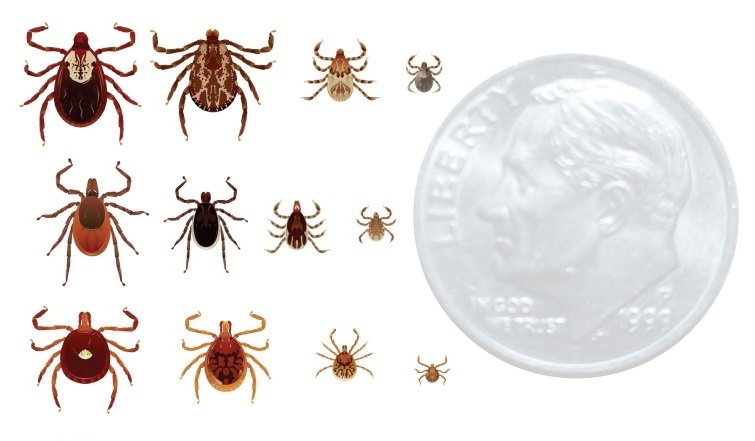
Protecting your dog
Take preventive measures to protect your dog.
Avoid Tick-Infested Areas:
Ticks are found in tall grass and wooded areas. To reduce your dog’s risk of tick bites, avoid taking them to places where ticks are known to be present.
Keep Your Yard Clean:
To reduce your dog’s risk of tick bites, keep your yard clean and well-maintained. Mow your lawn regularly and remove any leaf litter or debris that may provide a hiding place for ticks.
Use Tick Preventatives:
Several tick preventatives are available for dogs, including sprays, collars, tablets, and chews. These products kill ticks before they can attach to your dog’s skin. Talk to your veterinarian about the best tick preventative for your dog.
Consider vaccinations:
There are vaccines for some tick-borne diseases, such as Lyme disease. Talk to your veterinarian about vaccinations recommended for your dog.
Checking for ticks
Check your dog
After spending time outdoors, thoroughly check your dog for ticks. Start by running your hands all over your dog. If you feel a bump, spread his fur to see if it’s a tick. Be sure to check all the nooks and crannies – in and around his ears, eyelids, facial wrinkles, under collars, “armpits”, groin area, and between his toes. Sometimes they’ll even feed on your dog’s gums. Another option is using a special tick comb to pull off ticks.
If you find a tick, remove it using tweezers or a tick remover:
- Protect your skin with latex gloves.
- Using tweezers, pinch the tick close to your dog’s skin and pull away from the skin in a steady motion. Don’t twist or squeeze the tick because the head could break off.
- If you use a tick remover, slide it along your dog’s skin until you catch it in the notch. Pull away in a steady motion.
- Place the tick(s) in a small jar and cover it with rubbing alcohol. Ask your veterinarian if you need to bring it in for identification.
- Wipe a cotton ball soaked in antiseptic over the bite area.
- Then keep looking because there may be more.
Check yourself
Ticks can also latch on to people, so check yourself for ticks after spending time outdoors. You probably won’t feel them on your skin or even when they bite and start feeding because they inject an anesthetic. If you find a tick, remove it immediately using tweezers or a tick remover detailed above.
If you live in, or are visiting, an area with lots of ticks, check your dog and yourself daily.
Conclusion
Tick-borne diseases are a threat to your dog’s health and to your health. Taking preventative measures can reduce the risk of tick bites and tick-borne diseases.
Talk to your veterinarian about which tick preventatives are best for your dog.
Header image courtesy of Centers for Disease Control and Prevention
NOTE: The information on this website is not intended to replace your veterinarian’s advice. This information is intended to provide non-technical information in an easy-to-understand format. The website author accepts no responsibility or liability for how this information may be interpreted or construed, or any actions that might be taken as a result of the information herein.

Browse this list of helpful links for Labrador Retrievers – clubs, competition, health issues, and more.
To request a link to a Lab club website or other helpful link or to update an existing link, please contact us.
National & International Dog Clubs
American Kennel Club (AKC)
Canadian Kennel Club (CKC)
Federation Cynologique Internationale (FCI)
The Labrador Retriever Club Inc
Master Amateur Retriever Club (MARC)
Master National Retriever Club (MNRC)
North American Hunting Retriever Association
Dog show info
List of AKC Licensed Dog Show Superintendents
Hunt test and Field trial entries
Health
American College of Veterinary Ophthalmologists (ACVO)
American Veterinary Medical Association
ASPCA Animal Poison Control Center, 24-Hour Emergency Number
888-426-4435
Animal Health Diagnostic Center
Genetic & Health Testing
US Labrador clubs
Dallas-Fort Worth Labrador Retriever Club
Greater Atlanta Labrador Retriever Club
Heart of Texas Labrador Retriever Club
Huron River Labrador Retriever Club
Labrador Retriever Club of Greater Denver
Labrador Retriever Club of the Pioneer Valley
Labrador Retriever Club of Southern California
Labrador Retriever Club of the Potomac
Mid-Jersey Labrador Retriever Club
Puget Sound Labrador Retriever Association
San Diego Labrador Retriever Club
Spirit of St. Louis Labrador Retriever Club
Winnebago Labrador Retriever Club
Lab links
Coat Color Inheritance in the Labrador Retriever
Other
Dog Lovers Bookshop (hard to find used, out of print and rare books)
Therapy Dogs International, Inc. (TDI)
Header image AI generated via Canva
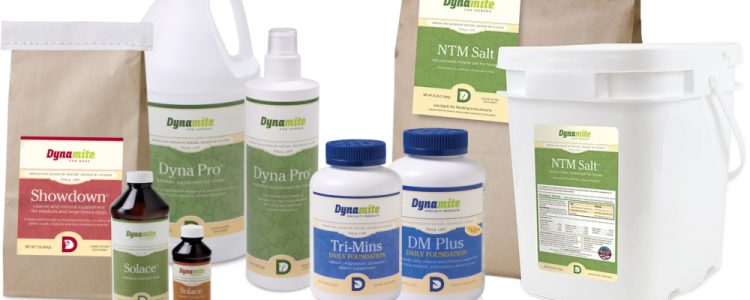
Dynamite products are made in the United States for better quality control, and using only natural ingredients.
“Its manufacturing processes are so stringently controlled that Dynamite has a separate mill to produce feed for herbivores, such as horses and poultry that are especially sensitive to contamination from meat needed by other species such as dogs and cats.”
I’m proud to be a Dynamite distributor for over 20 years!
I’ve had great results for both my animals and me. But because governmental regulations won’t allow us to make therapeutic claims, we can only tell you how we’ve used the products and share some stories from other people.
Stories and results
Free & Easy for People
As an aircraft mechanic, my husband misused his hands every day. That’s on top of a bad habit of popping his knuckles.
He tried soaking his hands in warm water every morning to make it easier to open and close his hands. I gave him a bottle of Free & Easy, but didn’t think he’d take them. When he did, I realized just how much he hurt.
He never said anything though. That is, until a few days after he ran out and had to resort to bathing his hands in warm water again. He actually asked for more F&E!
Free & Easy for Dogs
Story in a nutshell: Have an Australian Cattle Dog who will be 11 years old this August. He injured himself, caught his rear paw when running onto the deck early on.
He favored it on and off for quite some time. Got tired of meds from vet when he seemed to be favoring it from time to time. He actually got to a point, at one time, that he couldn’t go up the stairs.
So, looked for a more holistic approach. Researched the internet and found a site with testimonials on Free and Easy. Then researched the best price to buy which was from you.
At the time I began using Free and Easy also switched him to an organic, high quality dog food to which I add a spoon of pureed celery to each meal, as celery contains alot of water content which aids the joints in arthritic situations.
The vet not convinced about this, but I find the results to be good. And the rest is history. Don’t know if it is one item or combination of all, but he has not been on meds for this condition for years now.
R Witalec
DynaCoat
Well it worked, back to back Winners Bitch (had not earned any points for the previous two years).
Sandy Nixon
Showdown
The dog’s coats are what people comment on the most. They look like they have just been bathed they are so shiny. Their gums have a nice color as well.
Captain Tim Bradbeer
Beach and Bay Charters
Showdown
Bow is doing great. Still a ball of energy at 8 years and no signs of slowing down.
Robin Thorne
DM Plus, TriMins, Free & Easy and PMS
For years my mother would tell me every day that she needed to lay down because her back hurt.
Her doctors had her taking calcium pills for osteoporosis plus 800 mg Tylenol whenever she had pain. But it wasn’t until she came to live with me that I found out about the variety of medications she was taking.
The years of taking inorganic calcium had given her bone spurs and the daily Tylenol was causing other problems. So we weaned her off the medications that were contraindicated, provided her with better food choices, and started DM Plus, TriMins, Free & Easy and PMS.
The difference was almost immediate. In the almost 4 years she lived with me, I can only remember one time she had to lay down because her back hurt.
Products I’ve used and swear by
~~ For bumps, bruises, and immune support ~~
Solace
If I could only have one of the Dynamite products it would be a toss up between Solace and DynaPro. We’ve used Solace (200 ppm colloidal silver) topically and internally, usually diluted with distilled water, but occasionally full strength. For example, we used it combined with a homeopathic for cough when our dogs came in contact with kennel cough. They finished coughing within 24 hours, but a neighbor’s dogs continued coughing for two weeks.
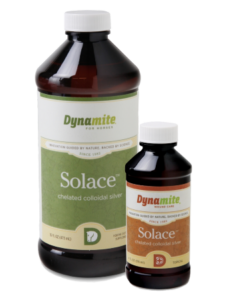
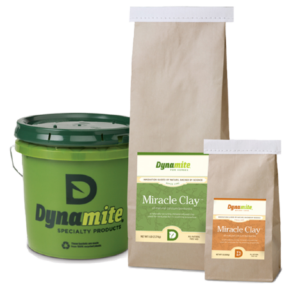
Miracle Clay
We’ve used Miracle Clay on all sorts of minor problems from bee stings, to bug bites, to rashes, to other swellings. We have wasps who give a nasty sting, but using a dab of activated Miracle Clay stopped the stinging within seconds. It’s been called a “Healing Gift from Mother Earth.”
Release
We’ve used it on sore muscles, blisters, and wounds. I even spray some on my face when I’ve been staring at the computer screen for too long.
Relax
We don’t use this product much anymore, but it’s been helpful for stressful situations such as the first trailer ride or a farrier visit.
My Labs are conditioned to gun fire from puppy-hood so July 4th fireworks don’t bother them at all. Not so for some dogs. Relax has helped other dogs get through that stressful day and adding Tranquil can provide additional help.
If your dog is stressed by fireworks, here’s a video that talks more about Dynamite’s Relax and Tranquil.
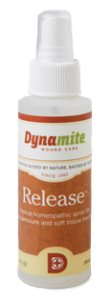

Tea Tree Oil
Cuts, scrapes and other injuries are topped with TTO. We’ve used it on us and the horses. However, I don’t recommend it for dogs unless it’s been very, VERY diluted.
Trace Minerals Concentrate
Whenever we need to stop minor bleeding, we use Trace Minerals Concentrate.
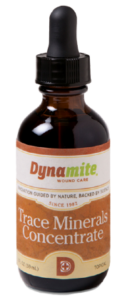
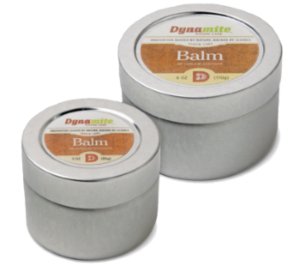
Wound Salve
We use Wound Salve on open wounds, usually with Solace and/or Tea Tree Oil.
Balm
We’ve had great results using Balm on bruises, old scar tissue, and even dry heels (prep for sandal season). By the way, Balm is used on closed wounds, while Wound Salve can be used on open wounds.
Izmine
“Izmine™ is an unusually effective mineral food containing more than 70 naturally-occurring minerals, enzymes, electrolytes and bio-nutrients in a readily-assimilated form. Its natural acidity contributes to its high degree of assimilation.”
It helped my dog recover after an ACL tear and helped my mom’s arthritis in her hands and back. They both also took Free & Easy.
Here’s a story about how Izmine was used to help dolphins who lived in chlorinated water. And when it was used to help a penguin that developed a large goiter.
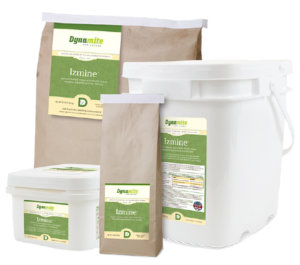
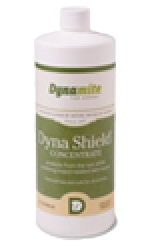
Dyna Shield
Love summer, but hate the bugs?
I’ve tried all sorts of products to keep bugs at bay, not only because they’re annoying, but also because they transmit diseases. Can’t say I’ve ever liked the stickiness and horrible smell though.
Then I tried Dyna Shield. It’s a concentrate that can be diluted at various levels to be used on horses, dogs and. people. It does have a smell, but more herbal than chemical. And it works well for my animals and me.
~~ For our canine companions ~~
Super Premium Dog Food
I’ve tried several premium brands of dog food and this one has given us great results.
It’s made with fresh, hand-trimmed USDA chicken, plus fish meal and salmon oil with only minimal processing. This helps preserve the natural goodness of the ingredients. NO corn or wheat. 24% protein, 16% fat. It comes in 8-pound and 40-pound bags.
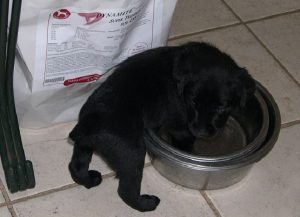

Showdown for Dogs / Showdown Pro
We started our Dynamite journey using Showdown and noticed quite an improvement in our dogs’ health. Coats became thicker and, in the case of chocolate Labs, a darker color.
We supplement breeding females with Showdown Pro, starting before breeding and continuing through weaning the puppies. The girls have maintained better condition and puppies get off to a great start.
DynaPro
I wouldn’t be without it! Anytime the dogs get stressed they get a couple of drops in their mouths or on their food. Weather changes, competition, breeding can all cause stress. By the way, we get the DynaPro for horses – same formula, bigger bottle, better price.

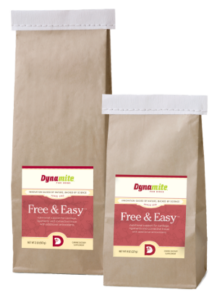
Free & Easy for Dogs
Our older dogs get Free & Easy six days a week.
One of our dogs was diagnosed with a partially torn ACL and the vet recommended immediate surgery. We chose instead to try conservative management (straight to rehab, skipping the surgery). It took awhile, but he went back to competing in hunt tests, obedience, and rally trials thanks to Free & Easy and Izmine.
Herbal Tonic
Twice a year we give our dogs Herbal Tonic to avoid having to use harsh chemical wormers. To be safe, we also test for heartworm.
For tips on how to use Herbal Tonic (and supporting products), check out Parasite Control: Balance vs. Eradication by Judy Sinner.
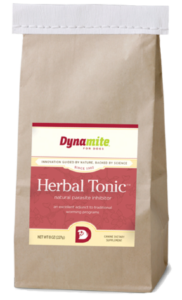
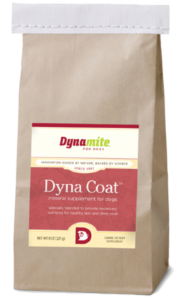
Dyna Coat
For show dogs, we’ve found DynaCoat has helped put on that extra bit of coat.
We also gave it to a dog that generally had a rather sparse coat. Within a few weeks she developed a nice plush coat. She even grew hair along her belly and inner thighs where she never had hair before.
~~ For people ~~
DM Plus
Yep, I take my vitamins too! Why take chances? I certainly don’t have the time to eat as well as I should, and I know with Dynamite I’m doing something good for the only body I will ever have.
Tri-Mins
As part of the Dynamite basic program, we take Tri-Mins for the additional minerals.
Some people have asked why Tri-Mins is separate from DM Plus. It’s because we each have different needs for the minerals in Tri-Mins (calcium, potassium, magnesium) and this allows you to adjust the amounts as needed.
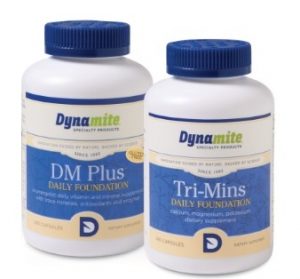
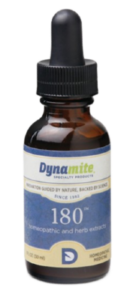
180
Worried about packing on the pounds during the holidays? I lost 30 pounds in two months using this 180 protocol and, overall, I found it to be pretty easy.
Elixir
I started the Dynamite program by taking Elixir mixed with water every day for 60 days. Now I take it whenever I feel a bout of heartburn coming on which, thankfully, isn’t very often.
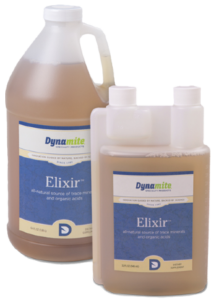
Horse products
Although my horses are leased out to a family with several children, they also get Dynamite products.
I like the Dynamite Plus for the additional coenzymes and herbs to help calm and balance the gut pH. (Regular Dynamite would be a good choice for a horse in competition.)
We also offer the Free Choice Minerals so each horse can eat as much or as little as they need.
When we were breeding horses we also used Breeder Pac. And, of course, they also get DynaPro and occasionally Herbal Tonic.

Key points:
- Blue-green algae is actually cyanobacteria that clumps together and looks like algae.
- Found in and around bodies of water during or shortly after hot, sunny weather.
- Can be clumps of blue, green, yellow, brown, or red — OR — can look like paint floating on the water.
- Dogs playing in or drinking affected water can become sick very quickly and can die.
As pet owners, we want to give our dogs the best possible care. However, sometimes even our best efforts can’t protect them from hidden dangers.
One such danger that’s becoming more common is blue-green algae, which produces toxins that are deadly to dogs.
What is Blue-Green algae?
They are a type of bacteria found in bodies of water, such as ponds, lakes, rivers, and even saltwater. It’s found throughout the world, generally when the weather is warm and sunny (or has been recently).
Usually blue-green in color, it can form dense mats, called blooms, on the water’s surface. These blooms can range in size from small patches to covering entire lakes. Or it can look shiny, oily, or like paint floating on the water.
Swimming or playing in contaminated water can cause hay fever-like symptoms, skin rashes, and respiratory and digestive distress. Drinking water contaminated with a high concentration of blue-green algae could cause liver and kidney damage. Symptoms often begin within hours.
Even short-term exposure can cause acute illnesses in people and dogs.
The dangers of blue-green algae for dogs
Dogs are generally more at risk, as they like to play and swim in the water and even drink it. Playing fetch in affected water can be twice as dangerous as the toxins may be swallowed and on the body.
Symptoms can appear within minutes of exposure, and can include:
- vomiting
- diarrhea
- weakness
- difficulty breathing
- seizures
- death
If your dog has been exposed to blue-green algae, it’s important to act quickly. Call your vet and describe any symptoms your dog has. If possible, bring a sample of the water with you to the vet to help with diagnosis and treatment.
Identifying blue-green algae
Although it can sometimes be hard to identify, tell-tale signs include:
- water that looks like pea soup, green paint, or blue-green scum
- foam or bubbles on the surface of the water
- clumps or mats on the water or along the shoreline
- a musty or earthy smell
If you think there’s blue-green algae in a body of water, keep your dog away from the water.
Test kits are available and testing can be done on-site with results in about 15 minutes. Amazon usually has these kits for about $25. Be sure to use waterproof gloves when collecting a sample. Nitrile exam gloves are readily available online or at a local pharmacy.
More dangers
Although swimming in or drinking affected water is the most common cause of illness, it’s not the only cause.
Recently a professional trainer was working the dogs in his care and when finished he let them all out to play. Several of the dogs stopped to eat something on the bank of a pond. The trainer thought it was goose poop because there were geese in the area.
That evening some of the dogs became ill. Despite veterinary care over the course of several days, six of the dogs died. Necropsies determined the dogs died from eating toxic algae. Most of the dogs were preparing to compete in field trails and were owned by the trainer’s clients.

Photo provided by Utah Division of Water Quality
Protect your dog from exposure
The best way to protect your dog from blue-green algae is to prevent exposure in the first place. Here are some things to keep in mind:
- Check for local advisories.
- Many states have websites that post advisories about blue-green algae outbreaks in local bodies of water.
- If you’re not sure about the safety of a body of water, keep your dog on a leash and away from the water.
- Blue-green algae thrive in stagnant water, so it’s best to avoid ponds or lakes that don’t have a lot of circulation.
- Be vigilant.
- Watch your dog closely for any symptoms when they are swimming or playing in the water. If you see any of the symptoms listed above, contact your veterinarian immediately.
Quick Reminder
Blue-green algae often grows in ponds and lakes when the weather has been warm and sunny. The toxins it produces can be deadly to dogs.
Check for clumps of blue-green algae in the water or along the shoreline. Sometimes it will look shiny, oily, or like paint floating on the water. If you’re not sure, keep your dog out of the water.
Test kits are available and only take about 15 minutes for results.
If your dog goes in or drinks any water that you suspect has blue-green algae, contact your veterinarian immediately for advice.
Be aware of the health risks and take precautions to reduce your dog’s exposure to contaminated water. Keep your dog safe and healthy so they can enjoy the outdoors.
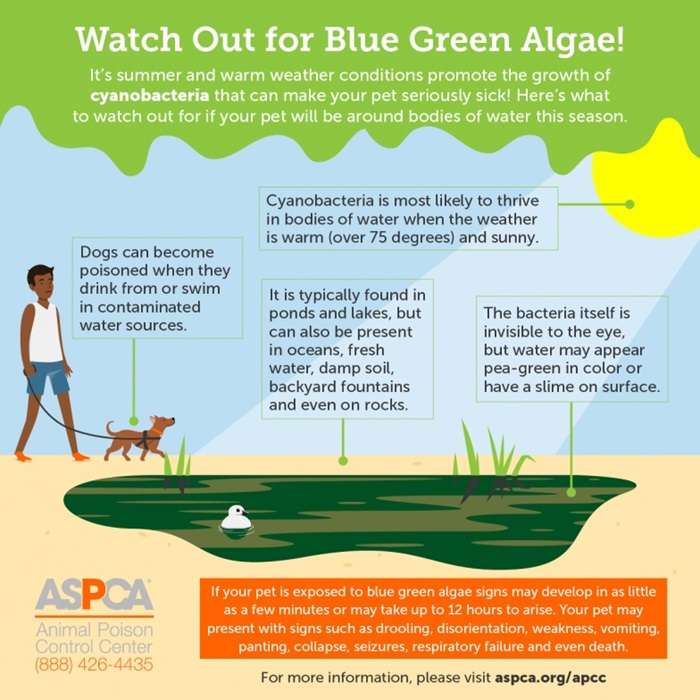
Header image courtesy California Waterboards – https://www.waterboards.ca.gov/
NOTE: The information on this website is not intended to replace your veterinarian’s advice. This information is intended to provide non-technical information in an easy-to-understand format. The website author accepts no responsibility or liability for how this information may be interpreted or construed, or any actions that might be taken as a result of the information herein.

Many people would have you believe the spay neuter decision is easy. “Yes!” and “Right away!” they’ll say. “We have to prevent pet overpopulation and animal suffering!”
But it’s not that straight forward. Not every intact animal contributes to overpopulation. Nor is spaying and neutering without pain and suffering.
Rescue organizations support spay neuter
As a country, I think we’ve made great strides in controlling pet overpopulation. Are there still animals in need? Certainly. Is spay neuter the answer in every case? No.
I believe our rescue organizations are desperately needed and deserve thanks from every pet owner. However there are still animals who wind up in shelters and never leave. I’ve been there. I’ve seen the piles of animals that had been “put to sleep.” It’s heart wrenching.
But spay neuter and rescue programs have helped to greatly reduce the number of animals in the shelters. In some cases the programs have worked so well the shelters need to import strays for local people to adopt. USA Today ran a story that an organization in Puerto Rico had shipped over 14,000 strays to the US for adoption.
Spay and neutering campaigns have been so successful in much of the USA — especially the Northeast and Northwest — that shelters need to look elsewhere if they want dogs to offer for adoption.
We shouldn’t be importing pets – and potential diseases – just to keep rescue organizations in business. Canine brucellosis was almost eradicated in the United States, but rescue groups in Wisconsin imported two dogs from South Korea that tested positive. This is a zoonotic disease which means it can spread to people as well as other dogs.
Several other imported dogs had rabies. At least one dog had been adopted by a family in Pennsylvania before they discovered he was infected. At that point, at least a dozen people may have been exposed.

Image courtesy wal_172619 via Pixabay
Health impacts of spay neuter procedures
Spaying and neutering has been good in some ways for society. But what about for the individual animal? There are many health consequences from these surgeries and plenty of misinformation.
“It’s a routine procedure.”
It may be routine for some animal hospitals, but it’s still surgery and, in the case of spaying, major surgery. There are risks from the surgery itself, from anesthesia, and from infection.
“It will reduce behavioral problems such as aggression and wandering.”
It may or it may not. Generally behavioral problems are better corrected through training.
“It can significantly prolong your pet’s life.”
Again, it may or it may not. There are several studies pointing to increased risk of various cancers and orthopedic issues due to spaying and neutering. There is also a study that showed female dogs lived longer if they were not spayed until at least six years of age.
“Spay neuter can make your dog friendlier and less likely to bite.”
Surgery doesn’t generally affect a dog’s temperament, although some studies suggest spaying or neutering can actually lead to more aggression.
“Irresponsible breeding is the root cause of most vicious dog bites and attacks.”
Poor temperament can certainly be inherited, but many dog bites are due to a training issue. There’s either a lack of training that lets a dog become an alpha or training designed to make a dog vicious.
“Spaying and neutering makes happier and healthier pets.”
A study found that “spayed female dogs tend to be more aggressive toward their owners and to strangers than intact females.” And there wasn’t much evidence that neutering would stop aggressive behavior in male dogs.
Spay neuter procedures explained
Spaying is surgery to remove a female dog’s reproductive organs.
Before the surgery, the veterinarian draws a blood sample. This checks the dog’s liver and kidney function because these organs break down and remove anesthesia after the surgery.
If all is well, the dog is sedated and her belly shaved and cleaned. The veterinarian cuts into the belly and removes the ovaries, fallopian tubes, and uterus. Then the incision is closed with sutures or glue and the dog is monitored as she recovers from anesthesia. Often she will remain at the hospital overnight.
After the dog goes home she will need to be kept quiet and prevented from licking or chewing on the incision.
Neutering is surgery to remove a male dog’s testicles.
As with female dogs, the veterinarian should draw blood to check for liver and kidney function.
Then the dog is sedated and cleaned before the veterinarian cuts into the scrotum. Each testicle is removed, the blood supply tied off, the incision closed, and the dog is monitored as he recovers. The dog should be kept quiet and prevented from licking or chewing on the incision.
Occasionally one or both testicles may be retained inside the body. In these cases the surgery is more involved and can be higher risk. These testicles are at risk of developing cancer so they should be removed or at least monitored via ultrasound.

Image courtesy whitedaemon via Pixabay
Advantages of spay neuter procedures:
- Prevents pregnancy and its risks
- Prevents females from coming in heat every 6-12 months
- Reduces or eliminates the chance of some cancers
- Reduces the risks of non-cancerous prostate disorders and perianal fistulas
- May reduce leg-lifting or marking by males
- May reduce the cost of licensing and/or HOA fees
Disadvantages of spaying and neutering:
- Costs of the surgery
- Risks of surgery, anesthesia and complications. Studies show about 20% of spay or neuter surgeries have at least one complication. Your dog may die due to the surgery. It doesn’t happen very often, but it’s pretty devastating when it happens to YOUR pet.
- INCREASED risk of other deadly cancers
- “INCREASED likelihood of hemangiosarcoma, lymphoma, mast cell tumors, and canine cruciate ligament (CCL) rupture in neutered dogs.”
Should you spay neuter your dog?
It should be up to you, based on complete and accurate information and the needs of you and your dog. You shouldn’t be pressured into a decision either way.
A big problem is that alleged health benefits are discussed, but rarely any evidence supporting that viewpoint. Also rarely discussed are the health risks of spaying and neutering.
Potential risks of neutering male dogs
- The risks of prostate or testicular problems are fairly low and, if any do occur, the solution generally is to neuter. On the other hand, there are other increased health risks due to neutering.
- If neutered before one year old, significantly INCREASES the risk of osteosarcoma (bone cancer). A common cancer in medium/large breeds with a poor prognosis.
- INCREASES the risk of cardiac hemangiosarcoma by a factor of 1.6. “According to Aaha.org, hemangiosarcoma is known as a “silent killer” because dogs often show no symptoms until the tumor has grown so large that it ruptures and spreads—too late to save the dog’s life.”
- TRIPLES the risk of hypothyroidism. A common disease that can be tricky to diagnose, but is fairly easy to treat. However the dog will need daily medication for the rest of his life.
- INCREASES the risk of progressive geriatric cognitive impairment.
- TRIPLES the risk of obesity, a common health problem in dogs with many associated health problems.
- QUADRUPLES the small risk (<0.6%) of prostate cancer
- Doubles the small risk (<1%) of urinary tract cancers
- INCREASES the risk of orthopedic disorders
- INCREASES the risk of adverse reactions to vaccinations.
Overall it seems the negatives associated with neutering are greater than not neutering. The exception being a dog with retained testicles should be neutered.
If you choose to neuter, you might reduce some of the negatives by waiting until the dog is mature – perhaps a year old for smaller breeds and two years old or more in large breeds.

Image courtesy Alkhaine via Pixabay
Potential risks of spaying female dogs
The decision for females is not so easy.
Uterian cancer, mammary tumors and pyometra can all be life-threatening. Pregnancy complications can also be deadly. Spaying can reduce, and in some cases nearly eliminate, these risks.
Also results can be different depending on WHEN they are spayed with early spaying having higher risks of various problems. A longevity study suggests females may live longer if they’re not spayed until they’re at least 4-6 years old. But each heat cycle increases the chance of pyometra and breast cancer.
According to The National Animal Interest Alliance, the negatives of spaying female dogs include:”
- If done before one year old, significantly INCREASES the risk of osteosarcoma (bone cancer). A common cancer in medium/large breeds with a poor prognosis.
- INCREASES the risk of splenic hemangiosarcoma by a factor of 2.2 and cardiac hemangiosarcoma by a factor of >5. This is a common cancer and major cause of death in some breeds.
- TRIPLES THE RISK of hypothyroidism.
- INCREASES the risk of obesity by a factor of 1.6-2, a common health problem in dogs with many associated health problems.
- Causes urinary “spay incontinence” in 4-20% of female dogs.
- Increases the risk of persistent or recurring urinary tract infections by a factor of 3-4.
- Increases the risk of recessed vulva, vaginal dermatitis, and vaginitis, especially for female dogs spayed before puberty.
- Doubles the small risk (<1%) of urinary tract tumors.
- Increases the risk of orthopedic disorders.
- Increases the risk of adverse reactions to vaccinations.
For a little more insight on spaying females, there is a study that concluded shorter lifespan was associated with spaying. They looked at Rottweilers that had an average lifespan of about 9-1/2 years compared with Rotties who lived to at least 13 years old.
Females tend to live longer than males, but it didn’t hold true for females that were spayed before 4 years old.
As they dug deeper, their results showed that how long females kept their ovaries affected how long they lived. If they were at least six years old before being spayed they were 4.6 times more likely to live an exceptionally long life. When they excluded all deaths due to cancer, they found “females that kept their ovaries the longest were 9 times more likely to reach exceptional longevity than females with shortest ovary exposure.”
If you don’t plan to breed your female, spaying would probably be the better choice, particularly if you delay the surgery until your dog is mature.
If you do have a breeding-quality female and plan to breed her, puppies nursing may provide some protection against the risks to unspayed females. Another option for unspayed females is postponing her heat cycles with a steroid, mibolerone.
Each time a female has a heat cycle her body produces increased levels of progesterone which is inflammatory to her uterus. Several heat cycles with this inflammation, particularly if she is not bred, can lead to endometritis, a uterine infection. Mibolerone can delay her heat cycle for up to two years, but must not be used before she’s cycled once naturally.
Once a female’s breeding career is over, spaying would be a good choice. Based on the Rottweiler study, waiting to spay until she is over six years old may help to extend her life.
Other options
With all the potential health issues caused by spaying and neutering, another option you might consider is hormone-sparing sterilization. These are more like a hysterectomy or vasectomy in people.
A female dog would have her uterus removed, but not her ovaries. She would still have heat cycles due to her hormones, but bleeding is eliminated. Ovarian and breast cancer are still possible, but the risk of ovarian cancer is small. Regularly rubbing her belly – particularly after she reaches middle age – can alert you to any suspicious lumps that could develop into cancer.
For male dogs, your veterinarian would cut the vas deferens – the tube that transports semen. There is still a chance of testicular cancer or an enlarged prostate, however these can usually be treated by neutering. In the meantime, he would have benefited by retaining his natural hormones until then.
The problem is that few veterinarians are trained in these procedures. Hopefully that will eventually change.
There are also some non-surgical options. Zeuterin (also labeled EsterilSol in some countries) is an injection that sterilizes male dogs. Unfortunately it’s not currently available from the manufacturer. Suprelorin is an implant for male dogs to prevent fertility. It takes about 2-3 weeks to reduce testosterone and 6 weeks to infertility. It lasts about 6-12 months. Unfortunately it is only available in a few countries, but not in the US or Canada.
Of course, another option is responsible pet ownership. In some countries, neutering is very uncommon or even outlawed. However it does take more effort, especially with an intact female.
Key Takeaways for Pet Owners
Spaying or neutering can have profound effects on your dog’s health and longevity. Consider the pros and cons. If you do decide to spay or neuter, wait at least until your dog is fully mature. This may be about one year old for small dogs and two years (or more) for large dogs.
Listed below are some websites with more information:
Gonadectomy – Rethinking Long-Held Beliefs
Long-Term Health Risks and Benefits Associated with Spay / Neuter in Dogs
Aggression toward Familiar People, Strangers, and Conspecifics in Gonadectomized and Intact Dogs.
Assisting Decision-Making on Age of Neutering for Mixed Breed Dogs of Five Weight Categories: Associated Joint Disorders and Cancers
Rottweiler study links ovaries with exceptional longevity
Determining the optimal age for gonadectomy of dogs and cats
Alternatives to traditional spay and neuter – evolving best practices in dog sterilization
Norway bans pet sterilization without a medical reason
Header image courtesy Edgar Daniel Hernández Cervantes via Pexels

So, you’ve decided a get a silver Lab. They’re trendy. They’re more unusual than other Labs. And they come in other uncommon colors such as charcoal and champagne.
Before you dig out your wallet though, learn about how they were created and the health issues they often have. Learn the truth about the silver Labrador myth.
Early Labrador History
The Labrador Retriever originated in Newfoundland and the early dogs were black. Some had white markings from the St John’s dog.
Several of these dogs were imported to England and Scotland during the 1800s. Impressed by their retrieving desire and overall work in the field, wealthy sportsmen imported more dogs and began breeding them. In the early 1900s, sportsmen in America began importing and breeding Labs.
The majority of these dogs were black, but breeders documented an occasional brown or yellow puppy. But black was – and still is – the most common color.
It’s notable that none of these early Labs were described as silver colored.
Origin of the Silver Labrador Myth
According to the Factual Review by Margaret Wilson, “There was never any mention in the meticulous and exhaustive breeding records, whelping logs, descriptions of markings colors, etc., and stud books kept by gentlemen of unimpeachable integrity of any dog being produced that was, in fact or in fantasy, a dilute. Not in ANY of the retriever breeds developed from the St. John’s dog during that time in Great Britain. The dilute allele was introduced after the establishment of the recognized breeds. In the case of the Labrador this introduction occurred in the USA during the latter part of the 20th century.”
Because a variety of breeds were crossed with Labs early in their history, occasionally mismarks popped up. Some had tan markings like a Doberman, some were brindled like a Great Dane, and some were splashed with white. These mismarks are rare, but they do still occur. Unlike the “silver Labs”, these dogs are considered purebred Labs.
There was no mention of “silver Labs” until the mid-twentieth century. And for years after that, they were only found in the US. There were none in the United Kingdom until 2006 when some silvers were exported from the US. If these silver dogs were purebred Labradors they should have appeared a long time ago in the breed’s home country.
Origin of the silver color
The color most likely comes from the Weimaraner which has “shades of mouse-gray to silver-gray” per the breed standard. Every dog of this breed has two copies of the recessive dilution gene (“dd”) which causes the silvery color.
The Labrador Retriever, however, does not have the dilution gene. A purebred Lab has “DD” genes which means they have two copies of the dominant, non-dilute gene.
Crossing Labs with Weimaraners will produce dogs with normal Lab colors, however, they will all carry the dilute gene (“Dd”).
Breeding these dogs together can produce dogs that don’t carry the dilute gene and dogs that carry one copy of that gene. These dogs will have normal Lab colors.
However, that cross can also produce dogs that have two copies of the dilute gene (“dd”) with diluted colors.
The dilute colors have been named “charcoal”, “champagne,” and “silver.” These dogs often have a lavender cast to the coat and light greenish eyes, both traits from the Weimaraner.
Honest Labrador breeders test their dogs for the dilute gene. A Lab with correct coat color – black, yellow, or chocolate – will be either DD or Dd. The DD means the dog does not carry the dilute gene. That small “d” means the dog has correct color, but also carries the dilute gene and is therefore a mix-bred.
The start of the silver Labrador myth
Just about every “silver Lab” can be traced back to two breeders – Crist Culo Kennels and Beaver Creek Labradors. They gained notoriety in the mid-1980s. Neither has a current website.
In 1987 the American Kennel Club (“AKC”) investigated a litter of silver puppies. After looking at the puppies and paperwork they decided “there was no reason to doubt that the dogs were purebred Labrador Retrievers.” That statement is not the same as saying the dogs were purebred. Rather it meant they had no proof the dogs were of mixed parentage. Genetic testing would likely have proven the records were falsified, but without it they relied on the breeder’s word. Read on to learn about his truthfulness. Or lack thereof.
Crist Culo Kennels
Dean Crist was the first person to market “silver Labs” and was adamant that they were purebred Labs. He even “offered $100,000 to anyone who could simply prove” he was cross-breeding to produce “silver Labs.” It was a safe bet without genetic testing.
The dogs at Crist Culo Kennels were intensely inbred. This was likely done to increase the number of dogs carrying the dilute gene and thus his profit margin.

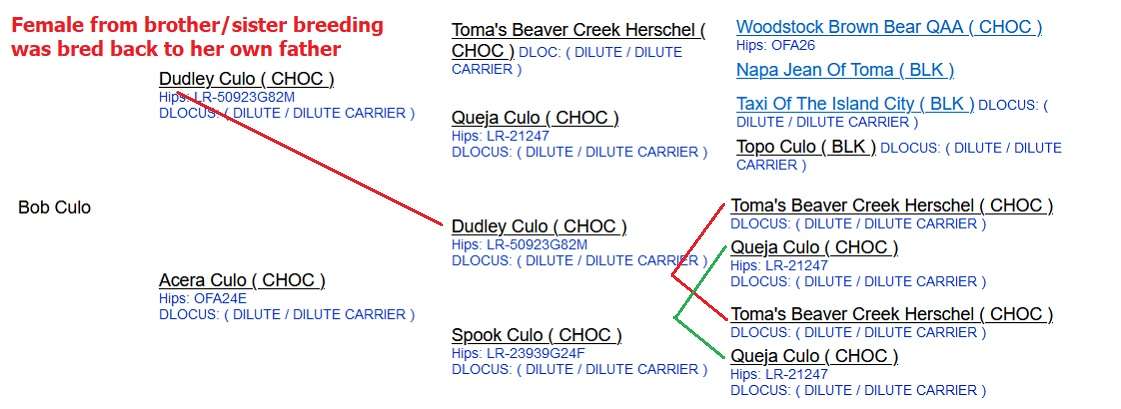

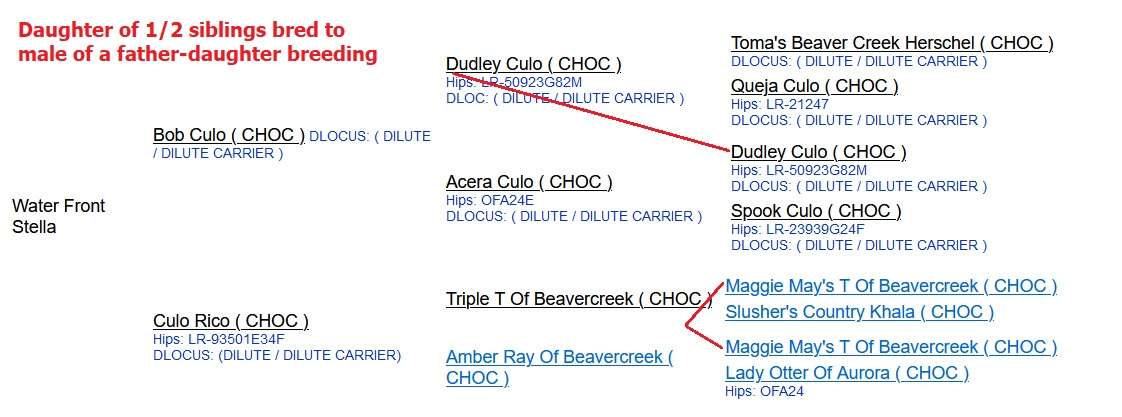
Crist claimed, “… AKC will eventually have to concede to the growing public pressure to make Silver a recognized color for Labs in America.” He didn’t know that AKC doesn’t have the power to make silver a recognized color of Labradors. The Labrador Retriever Club (“LRC”) controls the breed standard and they don’t recognize “silver Labs” as purebred.
He claimed, “Chocolate Labs were both controversial and rare in the U.S. in the early ‘80s.”
Although not as common as black Labs, chocolates were not controversial nor rare and many were champions:
Am Mex CH Gunfields Super Charger CD WC (born 1969),
CH Wingmasters Cobe of Mandigo CD (born 1972),
CH Shamrock Acres Pot of Fudge CDX (born 1975),
CH Wingmaster’s Swiss Ms CD (born 1977),
FC Mueller’s Stormy Canada (born 1980),
Crist said, “…allergies … occur at the same frequency in Silver Labs as they occur in Chocolate Labs.” He blamed puppy buyers for feeding a poor diet. Silver Labs commonly have color dilution alopecia, a genetic disorder that causes the dog to lose most of its hair.
Although retired from breeding, other silver breeders continue to spread his false information.
Beaver Creek Labradors
This kennel showed up in the 1990s – about 10 years after Crist Culo. They practiced less intense line breeding – using distant relatives – compared with the inbreeding done at Crist Culo Kennels. According to Crist, this kennel culled silver puppies until they saw him advertising “silver Labs” for sale. He volunteered to sell the puppies for them so they could avoid the backlash of cross-breeding. Eventually, they chose to market their own puppies.
Other people decided to try breeding silvers. Some sourced their first dogs from early breeders, while others decided to breed their own “silver Labs.” At least one breeder was caught falsifying records and was suspended from AKC.
Explaining the appearance of silver Labs
There are a variety of stories told to explain the sudden appearance of “silver Labs” in the 1980s.
Some silver breeders point to gray puppies noted by Mary Roslin-Williams. However, they only included the part that makes it seem like “silver Labs” have been around for many years. What they didn’t share is that when those puppies shed their puppy coat they were black. Not silver, not charcoal.
A researcher traced many silver pedigrees back to dogs from a large mid-western kennel. To register crossbred puppies with the AKC, a false name and registration number from a Lab had to be used as the sire. Therefore the dogs he pointed to were likely the “parents” only on paper as the actual sire was probably a Weimaraner.
Another oft-repeated myth is that the level of inbreeding at the Culo kennel resulted in the silver color. Rather the tremendous amount of inbreeding in these early silvers suggests producing the silver color was deliberate.
It only took one fraudulent breeding to introduce the dilution gene to the Lab breed. Then lots of inbreeding to develop a line of “silver Labs.” Since then there have been many more fraudulent registrations of Labrador x Weimaraner crosses registered as purebred Labs.
Interesting how there were no “silver Labs” until the mid-1900s. And for years after that they were only found in the US. There were none in the UK until many years later. The silvers there were all imported from the US or descended from imports. If these dogs were purebred Labradors they would have shown up a long time ago in the breed’s home country.
Creation of “Silver Labs”
They are a cross of a chocolate Labrador Retriever and Weimaraner. A first generation dog could look more like a Lab or more like a Weimaraner. Breeding together two first generation mixed-bred dogs could result in puppies with the silver color.
If the Labrador grandparent was black or yellow, some of the second-generation puppies could be a lighter shade of black or yellow. These colors were called “charcoal” and “champagne.”
Years ago it was really hard to tell a silver Lab from a Weimaraner. Unless you looked at the tail. In the US, Weimaraners have their tails docked to six inches. Other countries have outlawed cropping ears and docking tails, so looking at the tail in those locations is not helpful.
Over time, silver breeders have bred their dogs to purebred Labs so the silvers are looking more Lab-like. And they decided to lie and declare their mixed-breed dog are purebred Labradors. This is the silver Labrador myth.
Health Issues
Silver Labradors are prone to color dilution alopecia which is a painful and chronic condition linked to the dilute gene. Dogs appear normal as puppies, but at about six months begin to lose their hair. Some dogs may only have bald spots while others may lose all of their hair.
Affected dogs may develop infections and granulomas which are the body’s attempt to wall off foreign bodies. There is no cure.


Silver Labrador Myth Around the World
“The overwhelming consensus among breed experts from legitimate Labrador clubs, the position of these accredited Labrador clubs, and a growing number of recognized purebred dog registries, is that the dilutes are the result of a cross breeding, with Weimaraner being the source of the dilute allele, and are therefore are not registerable in a purebred registry.” LRC_News_Spring2018.pdf
In addition, the breed standards for Labrador Retrievers around the world only recognize the colors of black, chocolate and yellow. AKC lists any other color as a disqualification. Labs with the diluted color cannot be shown. Some countries do not allow them to be bred.
Labrador Retriever Club Inc.
The LRC is the parent club for the breed in the US and they are the liaison to the AKC. They do not condone the breeding of silver Labs and have “good evidence in scientific literature indicating that the Labrador has never been identified as carrying the dilute gene…”
In other words, these dogs are not purebred Labradors.
The United Kennel Club and Hunting Retriever Club
The UKC standard is clear. Any color or combination of colors other than yellow, black, or chocolate is a disqualification. UKC does not recognize any form of silver coloration as a variation of the chocolate color. It does not knowingly accept registrations for Labradors that have a silver coat coloring.
Further, they are not eligible to run in HRC hunt tests because the tests are only open to gun dog breeds. Dilutes are not considered purebred Labradors. They can participate in other UKC performance events but must be neutered.
Great Britain
Dilute colors in Labradors are not recognized
Canada
Not a breed standard recognized color for Labrador Retrievers
The Netherlands
Dilute colors are not naturally occurring in Labradors. Breeding dilute Labs is banned.
New Zealand
At least one parent must be clear of the dilute allele.
Australia
Dilute Labradors may not be registered.
American Kennel Club
On the other hand, the AKC is a registration body. Its position is if two dogs have full registration and are registered as the same breed, they will register their puppies.
Weighing the facts
Ultimately if silver breeders were truthful there would have been some backlash, but not to the extent caused by the lies. What Labrador breeders object to is calling these dogs “silver Labs” when they have Weimaraner characteristics beyond the silver color. It’s particularly noticeable in the head, ear shape, and eye color.
Too many lies have been told and too much false information has been spread by the silver breeders. The LRC has offered to help them set up their own breed, but they’ve refused. So it’s time to ferret out every one of these cross-bred dogs and stop calling them Labrador Retrievers.
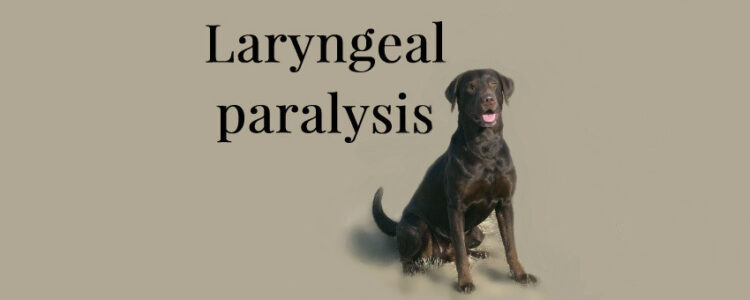
When my chocolate Lab was about 13 years old I noticed his bark was sounding hoarse. I thought he had a cold but after a check up with my veterinarian I learned it was laryngeal paralysis.
I made some changes to his care and lifestyle that helped him live to 17. He even “applied” for a drivers license on his 16th birthday.
Laryngeal paralysis in older dogs
The hoarse bark is a telltale sign of Laryngeal paralysis. Some dogs might have noisy or labored breathing. Others might faint from a lack of oxygen.
When you swallow wrong we often say “it went down the wrong pipe.” What happens is the flaps at the entrance to your windpipe didn’t close fast enough.
Laryngeal paralysis is the opposite – the flaps don’t open fully or sometimes not at all. That can cause several other symptoms such as:
- Noisy or raspy breathing
- Excess panting
- Coughing
- Gagging
- Regurgitating
- Exercise and heat intolerance
- Difficulty breathing
- Tongue or gums turning blue
- Collapse
The larynx – or voice box – is at the top of your dog’s throat. It regulates his breathing and includes vocal cords that make it possible for him to bark, growl, and whine.
This is where we find those flaps that keep food or liquid from entering his windpipe.
Sometimes because of age or injury, the larynx might not open completely. This can restrict your dog’s breathing, especially when excited or playing hard. He might also become anxious, pant excessively, cough, or gag.
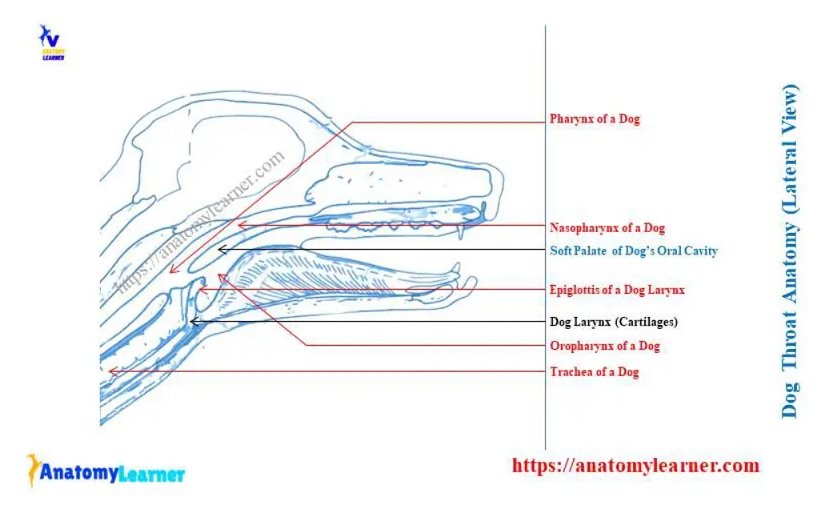
What is laryngeal paralysis?
Laryngeal paralysis is common in larger breeds, in dogs over 8-10 years old, and in male dogs. Although many breeds can be affected, Labradors seem to be affected most often.
It is often part of a neurological condition called Geriatric Onset Laryngeal Paralysis Polyneuropathy. GOLPP may cause mild symptoms for years or it can be part of a series of neurological dysfunctions.
Mega-esophagus is one symptom of GOLPP. This happens when food piles up in the esophagus instead of continuing into the stomach. If too much food gets stuck in the esophagus it can cause the dog to vomit. Aspiration pneumonia is another potential problem.
Another neurological dysfunction causes weakness in the rear legs. Often mistaken for arthritis, it’s actually caused by the same nerve problem that causes laryngeal paralysis. Slow leash walks and physical therapy can help weak rear legs.
Currently, there is no cure for GOLPP.
Causes of laryngeal paralysis
A genetic condition can cause laryngeal paralysis, especially in Siberian Huskies, Bull Terriers, Bouvier de Flanders, Great Pyrenees, and Dalmatians. Symptoms often begin in puppies under a year old.
There is also a non-genetic form that is likely caused by a neuromuscular disease. Or it can be caused by trauma, such as surgery, tumors or injuries to the neck.
Understanding the underlying cause is important as it helps guide treatment and care options.
Symptoms of Laryngeal Paralysis
Altered bark
Your dog’s ability to bark can be affected by laryngeal paralysis. It might become hoarse, weak, or even completely silenced. This change in the ability to make himself heard can be troubling for your dog.
Changes in breathing patterns
A change in the way your dog breathes is one of the most common signs of laryngeal paralysis. You may notice an increased effort to breathe, a raspy sound while inhaling or exhaling, and sometimes breathing difficulty. Sometimes it can sound like a goose honk.
When your dog’s breathing is restricted it can cause him to tire easily, faint or in severe cases, to die. Let your veterinarian know if you notice any changes in your dog’s breathing.
Exercise and heat intolerance
Dogs with laryngeal paralysis may have trouble working or playing and might tire more easily. They might need frequent breaks even during regular walks.
They may also have trouble regulating their body temperature which can make heat stroke more likely. Be sure to provide plenty of cool water and shade on hot days.
These symptoms are caused by the restricted breathing. Panting helps cool your dog’s temperature, but laryngeal paralysis can prevent him from panting effectively.
Other symptoms can include gagging, difficulty swallowing, noisy breathing, extreme panting, and exercise intolerance. If the larynx can’t close completely, food or liquid might “go down the wrong pipe” causing him to cough.
Diagnosis and treatment
If you notice potential symptoms of laryngeal paralysis, make an appointment with your veterinarian. The visit should include a medical history and a thorough physical examination.
Your veterinarian will likely listen to your dog’s chest and throat. He might also use X-rays or a scope with a camera which would require light anesthesia. Sometimes additional tests are needed.
Treatment options can depend on the severity of your dog’s symptoms and his state of health. In mild cases, medical management may be enough to relieve symptoms.
Medications might include mild sedatives to decrease anxiety and panting, which will improve respiration. Corticosteroids can help decrease any inflammation and edema (swelling) of the larynx.
You might need to make some changes such as taking walks in the cooler part of the day. If he’s overweight, helping him drop the extra pounds can make it easier to move around without huffing and puffing.
Here is a video of a dog that became anxious at the veterinary hospital and had trouble breathing.
Surgical intervention
In severe cases surgery could be considered. This procedure – often called “tie-back surgery” – permanently tacks open one side of the larynx which allows more air through and improves quality of life. Unfortunately this increases the risk of aspiration pneumonia and choking.
It also means no more swimming because dogs often swim with their mouths open. With one flap always open, he could drown.
After the surgery veterinarians will often prescribe a drug to help food pass quickly through the digestive tract. This helps prevent food from coming back up through the open larynx.
They may also prescribe anti-vomiting drugs for the same reason.
Be sure to check with your veterinarian about the potential benefits and risks to your dog.
Other options
Although there isn’t a cure for laryngeal paralysis, there are ways to minimize the symptoms.
You could choose a laryngeal stent implant instead of tie-back surgery. It doesn’t require surgery, it’s more affordable, and it only takes a few minutes.
Here’s one family’s story as they struggled to help their dog. At that time most veterinarians didn’t know – or perhaps didn’t care to know – about using a stent.
Acupuncture has helped manage symptoms. “Two acupuncture treatments four weeks apart were performed with marked improvement of clinical signs over a 6 week period. The patient continues to do well 16 months after the last treatment.”
An antidepressant drug called Doxepin seems to help 50-75% of dogs, however it doesn’t help with the underlying cause. Also it should not be given to dogs with glaucoma or heart disease. Because this is an off-label use for the drug you may need to sign a waiver before your vet will prescribe it.
The treatment plan should be tailored to your dog’s individual needs to improve quality of life and manage symptoms.
Caring for a dog with laryngeal paralysis
There is no cure, but mild cases can be managed using the following tips:
- Have plenty of fresh water available and a cool place to relax
- Reduce stress
- Provide anti-anxiety medications when necessary
- Use a sedative during exciting or stressful times
- Limit exercise, especially during hot and humid weather
- Use a harness rather than a collar to keep pressure off the throat
- Reduce excess weight
- Provide physical therapy to help rear leg weakness
- Check out ToeGrips if you have slippery floors
- Buy elevated bowls to reduce the risk of aspiration
- If your dog also has megaesophagus, a special chair called a “Bailey Chair” can help your dog sit upright and supported. Gravity helps the food “fall” into the stomach. Experts recommend feeding soft food and having your dog sit upright for 15 minutes after feeding.
Also schedule regular check-ups with your veterinarian. These follow-up visits will give him a chance to check your dog’s breathing, overall health, and response to treatment.
Recognizing and responding to emergencies
For a dog with laryngeal paralysis, problems can quickly become critical.
If you notice severe breathing difficulties, pale gums, excessive panting, or collapse, it can be a life-threatening situation. It’s important to act quickly. Be prepared to seek emergency veterinary care.
Summing up
All dogs with laryngeal paralysis need extra monitoring, some more than others. Learning about the symptoms and treatment options available can help you provide the best possible care.
Work closely with your veterinarian and don’t hesitate to seek their guidance when needed. Your care and support can help your dog continue leading a happy life.
NOTE: The information on this website is not intended to replace your veterinarian’s advice. This information is intended to provide non-technical information in an easy-to-understand format. The website author accepts no responsibility or liability for how this information may be interpreted or construed, or any actions that might be taken as a result of the information herein.
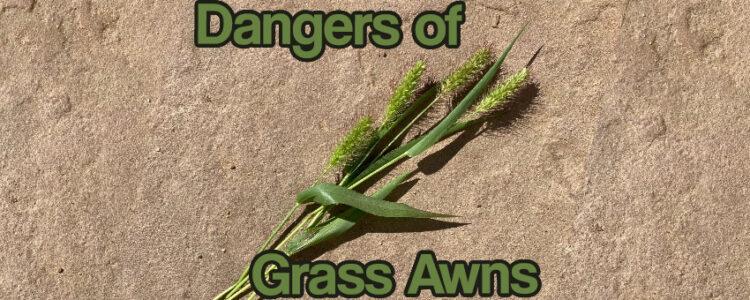
You’re probably well aware of the various health issues and hazards that can pose a risk to your dog. You might also have heard about the dangers of grass awns, but do you know why they’re dangerous?
Did you know that those idyllic fields of waving grain, as beautifully depicted in “America the Beautiful,” can pose a severe risk to your dog’s well-being? Yes, those innocent-looking plants hold the potential for grave health concerns.
Allow me to share a personal experience: Once, during our vacation, one of our dogs had a foxtail stuck in the corner of his eye. With no local vet clinics open, my resourceful mother got out her tweezers and had my brother hold our dog still. It took several minutes, but she grasped the foxtail deeply enough and pulled it out. Our little terrier was fine, if a bit put out over being so rudely man handled.
In this post we’ll learn about the dangers of grass awns and how you can safeguard your dog. Join us to learn about this hidden peril.
Understanding grass awns
What are they?
Grass awns are the seed pods of tall grasses that grow throughout North America. Sounds harmless doesn’t it?
Don’t be fooled though. They can create serious health issues in dogs and other animals.

The problem is their bristle-like structure helps them stick to anything – such as your shoelaces or your dog’s fur. They can also get into your dog’s nose, eyes or other parts of his body. And backward-pointing bristles make them hard to pull out. Worse yet, when your dog moves those awns can inch forward because of the bristles. They can even penetrate the skin and migrate around inside your dog’s body causing inflammation and infection.
Grasses that produce awns include:
- foxtails
- cheatgrass
- june grass
- timothy hay
- downy brome
- needle grass
- wild barley
- spear grass
- Canadian wild rye
- foxtail barley
- winter bentgrass / ticklegrass
Where and when are grass awns found?
Grasses, whether cultivated or wild, can have dangerous awns if they are unmowed and allowed to go to seed. Anywhere grass grows – in meadows, along trails or roads, and even in your yard – they pose a risk.
The grass itself is not dangerous. It’s the seed pod – or awn – that can cause health issues.
When grasses produce their awns can vary by location and weather. Generally they go to seed during dry and warm seasons. That might be for a short time at mid-summer for northern locations. Or it could be year-round in the warm south-western areas.
Dangers of grass awns
Grass awns, with their bristles, can become entangled in your dog’s coat when he runs through tall grass. Sometimes they’re tangled so completely that they can’t migrate. Although they can be hard to brush out, doing so can spare your dog pain and potential infection.
More likely the awns will move deeper into your dog’s coat due to their arrowhead shape and backward-pointing bristles. If they’re not removed they can pierce the skin and potentially migrate throughout his body.
If your dog hunts during the fall be sure to brush him thoroughly when you get home. Or run your fingers through his coat, feeling for awns or bumps which could be ticks.
Common places awns can lodge
The most common places these awns cause problems are between the toes, or in the eyes, ears, or nostrils. They’ve also pierced the gums or skin and have worked their way in through external genital organs.
Between Toes:
Grass awns can work their way between your dog’s toes, leading to irritation and possible infection. This is especially true for dogs with long or thick fur.
Eyes:
Grass awns can get trapped in a tear duct or behind the eyelid. This can cause redness, swelling, discharge, or even scratches on the cornea.
Ears:
Because of the ear canal structure, grass awns can migrate deep within causing irritation, inflammation, and infections.
Nose:
Dogs experience the world through their noses, but that puts them in danger of inhaling grass awns. Sneezing and rubbing their nose or face is a warning sign. Sometimes these awns migrate into the respiratory system causing serious health problems.
Under the Skin:
Another one of the dangers of grass awns it that they can penetrate the skin and travel through the body’s soft tissues.
Consequences of grass awn migration
After a day’s hunt or even just a romp in a field, grass awns can cause irritation and discomfort. If they’re not removed they can pierce the skin, introducing bacteria that can lead to an infection or abscess. An awn can migrate deeper into tissues and organs causing damage and potentially serious complications.
Sometimes the entrance wound heals and isn’t noticed. However, weeks or even months later your dog could develop odd symptoms. Your veterinarian might run tests without being able to pinpoint the cause of the symptoms all because of a migrating awn. Depending on its migration route it could damage your dog’s heart, lungs or even brain.
Treatment
When caught early, brushing or using tweezers works fine. However, if the awn is in a sensitive place or has punctured the skin, it’s time to visit your veterinarian. In that case, your dog will probably need to be sedated and the area shaved to remove the awn.
If the awn migrated deep into your dog’s body, your vet may use ultrasound to locate it and surgery to remove it. Sometimes the awn isn’t seen, but rather the path it took.
Another sign to watch for is when your dog has an infection and does well initially on an antibiotic, but then the infection flares up again. This can happen if an awn isn’t removed. Tell your vet if your dog has been in tall grass.
Prevention
Not all grasses produce awns, but it’s better to take precautions just in case.
Suggestions to minimize the dangers of grass awns include:
- whenever possible, avoid fields with grass that have gone to seed during the summer and fall
- brush your dog immediately after running in an area that may contain grass awns
- use your fingers to feel through your dog’s coat including the chest, armpits, belly, and groin areas
- visually inspect eyes, ears, gums, and between the toes
- consider trimming your dog’s fur in places where awns are likely to collect
- consider outfitting your dog with boots and or goggles
Symptoms of an embedded grass awn include:
- non-healing wound
- areas of redness and swelling
- limping
- head shaking
- sneezing
- scratching ears or face
- discharge from eyes or nose
Summary
Grass awns, often known as foxtails or grass seeds, can cause lots of problems for your dog. Most of the problems happen in late summer and early fall just in time for hunting season.
You can avoid areas with tall grass, particularly when it’s gone to seed. If you have a dog with long hair, especially on their feet, you can keep them trimmed. You can check your dog every time they’ve been in tall grass. Pay particular attention to their feet, nose, eyes, ears, armpits and groin.
Although prevention takes more effort, checking your dog can minimize the dangers of grass awns. If you find or even suspect a grass awn foreign body, contact your veterinarian as soon as possible. The quicker it is removed, the better the chance of a successful outcome.
NOTE: The information on this website is not intended to replace your veterinarian’s advice. This information is intended to provide non-technical information in an easy-to-understand format. The website author accepts no responsibility or liability for how this information may be interpreted or construed, or any actions that might be taken as a result of the information herein.
A friend’s dog had a bad reaction to Advantix II, one of several types of topical flea and tick products. She lives in an area with lots of ticks and had used the product for years without a problem.
But recently her dog became agitated and anxious. He ran around the yard like he was panicked, hid in the bathroom and behind a table.
He’d just had a dose of Advantix II the evening before.
When she called the Advantix emergency number, she was told “it feels like tiny needles and burning all over his skin.” She bathed him with a degreasing soap (Dawn) and gave him some Benadryl. Luckily the dog is doing fine now.
What you should know
Advantix II can cause:
- skin irritation such as redness, scratching, or other signs of discomfort
- gastrointestinal signs such as vomiting or diarrhea
- lethargy or agitation
- sensation of burning, tingling, itching, redness or numbness of the skin
If you search on ‘Advantix II Paresthesia’ you’ll find several cases where dogs have had a bad reaction.
Also keep cats away from treated dogs for 24 hours. Cats can’t metabolize some compounds in tick products which may cause serious health issues.
Someone who replied to her post, suggested avoiding Nexgard because her friend’s dog started seizing after using it. That dog died.
Another reply talked about a dog that “started having grand mal seizures. Over time they got worse and started clustering.” They traced the reaction to Frontline, and the seizures stopped when they stopped using Frontline.
Yet another reply said she “used K9 Advantix one time and my girl had a stroke from it!!”
Bravecto is another product that was discussed. Some people like it, but it’s suspected of causing sterility.
Bottom line?
Be very careful of chemicals used on your dog. Flea and tick products are designed to spread and coat the whole body. Although that may help prevent fleas and ticks, it could cause health issues.The skin is the body’s largest organ and plays a big role in the maintenance of health.
Instead, check your dogs when they’ve been in a tick-filled area and pull any ticks off manually.
One product I use with good results is Dyna Shield. It’s a blend of essential oils, herbs and plant extracts and can be used on people, dogs, cats and horses. Click to learn more about Dyna Shield and other products from Dynamite Specialty Products.
If you must use some sort of chemical, check out diatomaceous earth. I haven’t used it, but I’ve heard it has good results with few to no side effects.
Originally posted June 11, 2018.
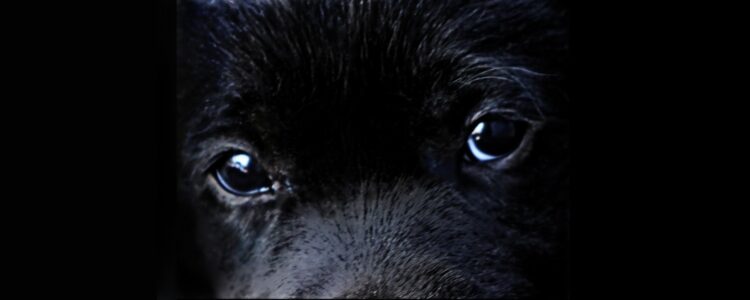
An annual eye exam can help identify problems early, but it also helps breeders make good decisions about which dogs are suitable for breeding.
Some eye problems are due to injury, some are due to age and other problems may be genetic. An eye specialist can determine the cause of a problem and provide treatment options, if necessary.
For many years the exam was known as CERF based on the Canine Eye Registration Foundation. Recently it’s changed to CAER (Companion Animal Eye Registry) which is affiliated with the Orthopedic Foundation for Animals (“OFA”).
Why it’s important
An annual eye exam should be included in every breeder’s health care plan because many eye problems are genetic and can affect puppies. Unfortunately many eye diseases have not been studied adequately due to time and funding shortages. In these cases the ophthalmologist relies on informed opinions and statistical information. Other disorders have a known genetic basis and testing can often be done by sending a cheek swab to a lab for analysis.
Puppies as young as 21 days can be examined. The exam should be repeated annually, at least through the dog’s breeding career.
Eye exams are also a good idea for dogs that won’t be used for breeding as problems are often easier to treat when they’re caught early.
Who can do the exams
These exams can only be done by a board-certified ophthalmologist.
Although your regular veterinarian has had some training in eyes and vision, unless she has had several years additional training and passed the American Board of Veterinary Ophthalmology certifying exam, she is not qualified to do these exams.
There are several ophthalmologists in the greater Denver area, a few around Fort Collins/Loveland and a couple in Colorado Springs. In surrounding states, there are none in WY, four in UT, three in NM, one in NE, and five in KS. Use the search function to find an ophthalmologist near you.
Each one sets their own price and currently they range from $45 to over $100. Another option is contacting a local dog club, particularly one that hosts dog shows. Occasionally they will also host a health clinic during the show. Many only offer eye exams, but others might offer cardiac testing, vaccinations, blood draws for heartworm and/or genetic testing. Often the testing is done at a reduced price. Because they’re popular, you need to sign up as soon as the testing is announced.
What happens during the exam?
The exams are screenings performed by board certified veterinary ophthalmologists to check for changes within the eye that indicate one or more eye diseases. The exams can be done at their office or sometimes at special clinics held at dog shows and other events.
You’ll start off by filling out a form with your information and your dog’s information including: registered name, registration number, date of birth, sex, breed/variety, permanent identification (via microchip or tattoo). An assistant will also use special eye drops to dilate the eyes. Expect dilation to last 6-8 hours. After about 15 minutes or so, you’ll meet with the ophthalmologist in a darkened room.
Note: Some breeds need to be examined before and after eye drops. They include:
- Australian Shepherd
- Dalmatian
- Louisiana Catahoula Leopard Dog
- Miniature American Shepherd
- Miniature/Toy Australian Shepherd
The exam often starts externally, looking for things such as injuries, eyelashes rubbing the cornea or growing where they shouldn’t be growing. The vet will use other equipment to magnify the interior of the eye looking for tiny anomalies in the lens, cornea and middle chamber of each eye. Then all parts of the retina are checked. Sometimes there are mirrors in the equipment that allow you to see exactly what the vet sees.
The exam generally only takes a few minutes, depending on how well your dog cooperates. Afterward you’ll get a copy of the exam form.
Eye diseases
Although there are many eye diseases that can affect dogs, very few have been adequately studied. Such studies require large numbers of related animals, sometimes several generations of dogs, and often the diseases don’t manifest until the dogs are older.
Currently there are 10 diseases with evidence that they are inherited or cause a significant problem. Signs of these diseases require an automatic fail on the eye exam.
Other diseases are presumed to be genetic, but lack a peer-reviewed study showing the mode of inheritance. These will show on the form as a “breeder option.”
Submitting to OFA
You can send the form with a small fee to OFA for certification. If your dog has passing results (including “breeder option”) you’ll get a certificate and the results will be posted on the OFA website. If the results weren’t passing, you can send those to OFA as well. There is no charge and no certificate. You can also choose whether to make those results public or not.
Certification needs to be repeated every year.

Super Bowl, March Madness and many exciting games are coming up. Do you put out snack foods and drinks so you don’t miss any of the action? If you do, I’d bet you unintentionally include some people foods dogs shouldn’t eat.
Although sometimes it seems like dogs can eat anything – yeah, even that – they really shouldn’t. Just ask your veterinarian what they’ve had to surgically remove – probably lots of socks, toys, rocks and more.
The problem is some people foods can make them sick or even die.
And unfortunately it’s not that uncommon. According to WebMD, there are “more than 232,000 pet poisoning” cases in the United States every year.
Potentially deadly foods
Dogs have different digestive systems and dietary needs than we do. So, although we might eat these foods regularly, they can be poisonous and even deadly for dogs.
- Alcohol
- Chocolate
- Coffee, tea, soda, energy drinks
- Fruit pits
- Garlic, Onion, Chives
- Macadamia nuts
- Raisins, grapes, currants
- Xylitol
If you think your dog ingested one of these items, contact your veterinarian for advice. If that’s not possible, call:
ASPCA Animal Poison Control Center
Or
The Pet Poison Helpline
There may be a fee for help from the above hotlines.
Common symptoms
Depending on what your dog ate, symptoms may start quickly or may take a few days. Here are some symptoms to watch for:
- Excessive vomiting and/or diarrhea
- Bloody urine or stool
- Inability to go to the bathroom
- Lethargy
- Irregular heartbeat
- Difficulty breathing
- Agitation
- Obvious signs of pain
- Seizures
- Collapse
If your dog ate one of the potentially deadly foods or if you see any of the above symptoms, get him to your veterinarian quickly. The sooner treatment is started, the better the chance of a good outcome.
More about potentially deadly foods

Alcohol
Some people think it’s harmless or maybe even funny if a pet gets drunk. What they fail to realize is their different metabolism, and often smaller size, makes dogs more susceptible to the effects.
Dogs seem to be more attracted to the sweeter drinks, such as eggnog, pina colada and daiquiri. However beer is also well liked.
Also be careful with foods that might contain alcohol, such as rum balls at Christmastime. And rotting or fermenting fruit, such as plums that fell from the tree, can cause similar symptoms.
Like people, dogs may be uncoordinated, may vomit or have diarrhea. At higher doses, dogs may have trouble breathing, tremors, heart arrhythmias, low blood pressure, coma and even death.

Chocolate
Yes, yummy chocolate is toxic to dogs. A substance in chocolate, called methylxanthines, contains both caffeine and theobromine. These are stimulants and can cause vomiting, diarrhea, hyperactivity, tremors, pancreatitis, irregular heart function, seizures and even death.
The darker the chocolate, the more dangerous it is for dogs, with baking chocolate having the highest levels of methylxanthines. Some chocolate products may also have other toxic ingredients, such as Xylitol or high amounts of caffeine.
Also be careful of foods that might contain chocolate – ice cream, cookies, cake and other sweets. And be aware on holidays, such as Valentines Day, Easter and Christmas, as chocolate is commonly given as gifts.
If your dog ingests any type of chocolate, even in small amounts, you need to call your veterinarian as soon as possible. Symptoms can take awhile to start – anywhere from a few hours to a day.

Coffee, Tea, Soda, Energy Drinks
Caffeine is the major culprit in these drinks. A small sip may not cause any harm, but ingesting a large amount can cause an increase in heart rate, abnormal heart rhythms and elevated blood pressure. Symptoms usually start within one to two hours after ingestion.
Other symptoms include vomiting, diarrhea, difficulty breathing, tremors, seizures and even death.
Pets are more sensitive to caffeine than we are. Other potential ingredients in these drinks that can cause harm are Xylitol and high levels of sugar.
Coffee grounds (often used in gardens), coffee beans, instant granules, tea bags, loose-leaf tea are all more concentrated than a sip of a drink. If your dog ingests any of these, call your veterinarian right away.

Fruit Pits
Slices of fruit are generally fine for dogs, but don’t give them whole fruit because seeds and pits contain poisonous cyanide. This includes apples, apricots, cherries, plums, peaches and other fruit with pits.
One or two apple seeds are probably not harmful, especially if they’ve been swallowed and not chewed. But what dog can resist chewing? Chewing releases the cyanide which blocks red blood cells from transporting oxygen. It’s safer for your dog if you slice and remove the core before giving it to him.
Symptoms to watch for include vomiting, panting, bright red gums, difficulty breathing, shock, dilated pupils, irregular heart beat, increased heart rate, seizures, coma and even death.
Canned and preserved fruit often have high amounts of sugar, preservatives or artificial sweeteners which can cause an upset stomach. Dried fruit, such as prunes, can also cause digestion issues.

Garlic, Onion, Chives
It may be hard to believe, but plants from the Allium family – including onions, chives and garlic – are not safe for dogs to eat. They contain sulfoxides and disulfides which can damage red blood cells. Damaged red blood cells can’t carry oxygen around the body which leads to anemia.
Garlic contains higher levels of these compounds and is thus more toxic to dogs. A bite of garlic bread might not cause any problems, but raw bulbs of garlic are more concentrated and dangerous. One onion is enough to cause toxic effects. Green onions and chives are less concentrated, but can be dangerous if your dog consumes a large amount.
All parts of these plants – bulbs, leaves, juice and processed powders – are toxic to dogs.
These are also common ingredients in many prepared foods, such as pizza, spaghetti, soups, stews and various meaty dishes. Be careful with leftovers too.
Symptoms can include pale gums, weakness, excessive drooling, discolored urine, gastrointestinal irritation, vomiting, diarrhea, anemia and collapse. It may take awhile, so if you think your dog may have eaten some watch for symptoms for at least a few days.
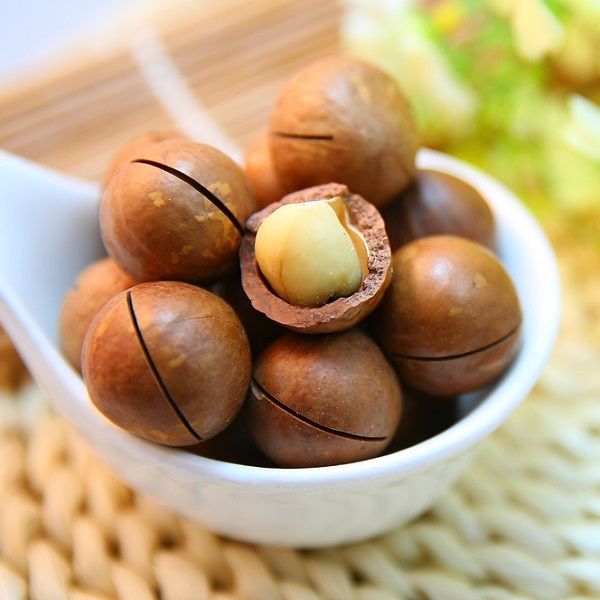
Macadamia Nuts
According to the American Kennel Club, “These are some of the most poisonous foods for dogs.”
They are a common snack food and can be found in trail mixes and baked goods. It only takes a few nuts to cause severe poisoning. However why these nuts are so toxic to dogs is unknown.
Macadamia nuts can cause depression, weakness, vomiting, abdominal pain, tremors, high fever, lethargy and inability to walk (particularly with the hind legs) and increased heart rate. Symptoms usually appear within hours after ingestion and may last for 24 to 48 hours.
If there’s a chance your dog ingested some, call your veterinarian right away.
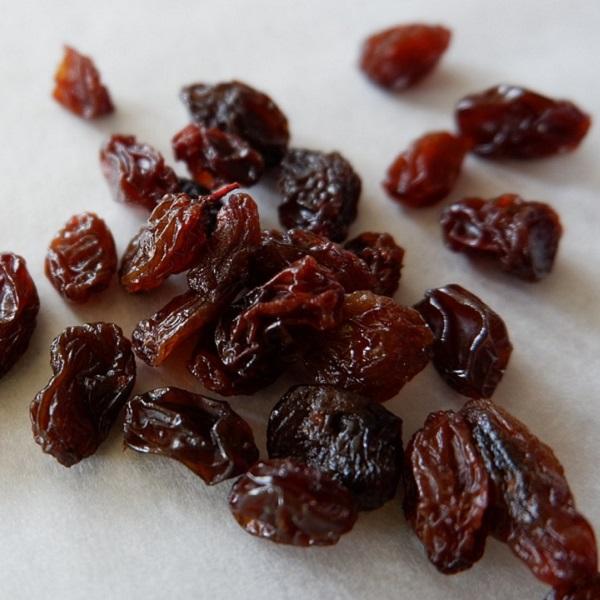
Raisins, Grapes, Currants
Although still surprising to some dog owners, raisins, grapes and currants are extremely toxic to dogs. They can cause severe liver damage and kidney failure. Some dogs have died after eating less than a handful of raisins.
Why they are so toxic to dogs is still a mystery. As is why some dogs develop severe symptoms while other dogs can ingest some and seem fine.
According to Merck, “Most dogs with raisin or grape toxicosis develop vomiting and/or diarrhea within 6-12 hours after ingestion of grapes or raisins. Other signs include lethargy, anorexia, abdominal pain, weakness, dehydration, polydipsia, and tremors (shivering).”
More severe symptoms may be seen in 24-48 hours with severe kidney damage.
Raisins are found in many baked goods, such as fruit cakes, raisin bread, bagels, cakes and cookies. They’re also in cereals and trail mixes. Grapes are made into jellies and juice. If you grow grapes or currants make sure your dog doesn’t have access to that area.
Call your veterinarian immediately if you think your dog may have eaten anything containing raisins, grapes or currants.
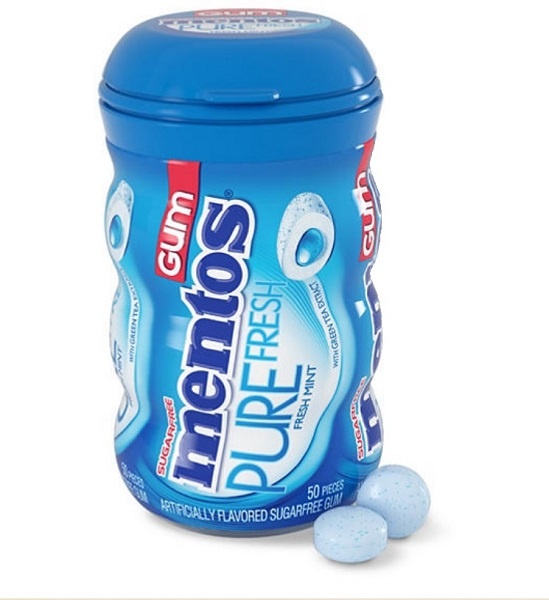
Xylitol
White sugar is bad for you. So instead food processors are making sugar-free products using a substitute originally made from wood chips or straw. It’s called Xylitol and is an ingredient in many gums, breath mints, candies, desserts, toothpastes and mouthwashes. It’s also found in pet mouth wash and oral rinses!
Unfortunately it can be deadly for dogs.
Xylitol can cause a spike in insulin, leading to a rapid drop in blood sugar levels in dogs. If sugar levels drop too low, your dog could become hypoglycemic with potentially harmful side effects. A higher dose can be life-threatening within minutes.
According to the Pet Poison Helpline, “to achieve a potentially toxic dose, a 10 pound dog would only have to eat one piece of gum!”
Reports of dog poisoning cases involving Xylitol are increasing.
Symptoms may develop within minutes of ingesting Xylitol. Blood sugar drops, the dog could start vomiting and staggering. Collapse and seizures are also possible. Some dogs may not show signs for hours, perhaps because of ingesting a smaller amount.
Within a few days some dogs have developed liver failure. Some dogs have died.
The quicker the dog receives treatment, the better his chance of surviving. He will likely be made to vomit, receive fluids and frequent tests of his blood sugar levels and liver function. This is in-hospital care.
Other people foods dogs shouldn’t eat
Snacks
Potato chips, pretzels and salty snacks:
These products are often very salty which makes pets thirsty and in turn causes urination. Sometimes in the house.
Too much salt can be extremely toxic. Symptoms include vomiting, diarrhea, depression, tremors, loss of coordination, abnormal fluid accumulation, increased body temperature. Higher doses can damage the kidneys and may lead to seizures, coma and death.
Soups and stews can also be high in salt. Driveway de-icers can also contain a high amount of salt.
If your dog has ingested a lot of salt and has any of the symptoms, contact your veterinarian immediately.
Nuts:
Can be dangerous if not chewed well. Salted peanuts can be dangerous if the dog eats many. See the issues with salt above.
Pizza:
A small bite of plain pizza or bread (no spices, garlic, onion, spicy processed meat) should be fine. However the dough is not nutritious and the tomato-based sauce and common toppings can cause health issues. Never give pieces containing garlic or onions.
Popcorn:
Unsalted and unbuttered popcorn is fine in moderation, but make sure there aren’t any unpopped kernels that could be a choking hazard.
Candy:
Don’t give these to dogs. Hard candies can be a choking hazard. Some candies may contain Xylitol which is toxic to dogs. Chocolate can be deadly.
Dairy
Milk:
When puppies are weaned, they no longer need milk. Some dogs can digest milk, but many dogs are lactose intolerant and shouldn’t be offered milk or any dairy product. Symptoms can include diarrhea, vomiting and/or gas, allergic reactions and even pancreatitis.
Cheese:
It’s generally fine in small amounts, except for dogs that are lactose intolerant. It’s also high in fat, so give it sparingly.
Ice cream:
This is a common treat, but some dogs are lactose intolerant. It also contains a lot of sugar and fat. Offer it sparingly, if at all. Also some flavors can be toxic, such as flavors containing chocolate and/or raisins.
Yogurt:
If your dog can digest dairy products, plain yogurt is an acceptable snack. However as in ice cream, be aware that some flavors can be toxic to dogs.
Fatty Meats
Bacon grease:
Avoid giving your dog leftover fat and grease as too much can lead to stomach upsets or even pancreatitis. An inflamed pancreas is painful and may require hospitalization and IV fluids. Some breeds are prone to pancreatitis.
Gravy:
Gravies are often fatty and salty – either of which can irritate your dog’s stomach. They may also contain toxic ingredients such as garlic or onions. However you can make or buy a very lightly seasoned gravy for a finicky eater.
Poultry skin, Ham and other fatty cuts:
As with bacon grease, it’s better to throw these items out.
Other
Avocado:
Some people believe dogs should not eat avocados. This is because the skin, pit and leaves contain a toxin called persin. However dogs and cats can eat it. But “other animals, particularly birds, will find avocado toxic.”
Avocados do provide health benefits, but to be safe only give your dog small amounts and only the meat. Remove the skin, pit and any leaves. Dispose of those pieces in a way other animals can’t access them.
Also avoid giving your dog avocado products, such as guacamole, because they often contain ingredients – such as onion – that are harmful to dogs.
Chili peppers:
Don’t give these to dogs. Although they aren’t toxic to dogs, they can irritate their stomach and intestines. They can cause stomach cramping, bloating, vomiting, drooling and/or diarrhea.
Citrus fruits:
Don’t give these to dogs. Lemon, limes, oranges and grapefruits have toxic compounds in the skin and seeds and can cause vomiting and diarrhea.
Cooked bones:
Don’t give these to dogs. Cooked bones can splinter and cause punctures in the stomach and/or intestines. They can also cause choking, digestive upsets and blockages.
Human vitamins and medications:
“Do not give human medications to your animal unless directed by the vet.”
Some medications meant for people may not work for dogs. They may cause adverse effects, including death.
Mushrooms:
White mushrooms from the grocery store should be okay to give your dog, but don’t let him eat any mushrooms growing wild. “Veterinarians recommend treating all wild mushrooms as potentially toxic and a veterinary emergency.”
Nutmeg:
Don’t give this to dogs. Nutmeg contains myristicin which can cause high blood pressure, increased heart rate, abdominal pain, hallucinations and seizures. If your dog does get into the nutmeg shaker or the pumpkin pie, contact your veterinarian for help.
Potatoes and Tomatoes:
Avoid giving your dog potatoes or tomatoes as both belong to the nightshade family of plants and can be toxic. A ripe tomato should be fine, but the rest of the plant and green tomatoes contain toxic solanine. A cooked potato should be fine, but a raw potato, particularly one that has sprouted or turned green is toxic. Leaves and stems are also toxic. Never give raw potato peelings.
If you grow either in your garden, make sure your dog can’t access them. Stems, leaves and green tomatoes contain higher amounts of solanine. Immature potatoes also contain higher amounts of solanine.
Symptoms of solanine poisoning include vomiting, diarrhea, lethargy and even seizures. Ingesting large quantities can cause a slowing of their heart rate, vision issue and possibly heart issues.
Rhubarb:
Leaves are toxic and ingestion could cause kidney failure. Symptoms include drooling, vomiting, diarrhea, trembling, bloody urine, lethargy, coma and even death. The leaves are bitter tasting so most dogs will avoid it. If you have rhubarb in your garden make sure your dog can’t access it.
Tobacco:
Although it’s not a food, dogs have ingested cigarette butts, chewing tobacco and liquid nicotine. Symptoms include excessive drooling, tremors, excitement, vomiting, diarrhea, increased heart rate, rapid breathing, constricted pupils, agitation, seizures, blue gums, coma and even death.
Yeast dough:
Yeast is what causes dough to rise. If a dog ingests the dough it may continue to rise and cause gas to accumulate in his digestive system. This can cause severe pain and possibly torsion or rupture of the stomach – a life-threatening emergency. Contact your veterinarian or emergency clinic.
Additionally the yeast and sugar in raw dough ferments and becomes a type of alcohol that can cause alcohol poisoning. Contact your veterinarian if your dog has a swollen belly, stomach pain or is trying to vomit.
NOTE: The information on this website is not intended to replace your veterinarian’s advice. This information is intended to provide non-technical information in an easy-to-understand format. The website author accepts no responsibility or liability for how this information may be interpreted or construed, or any actions that might be taken as a result of the information herein.



